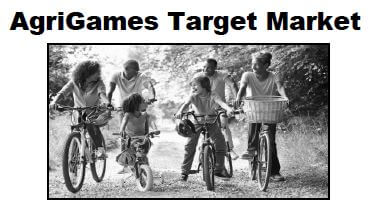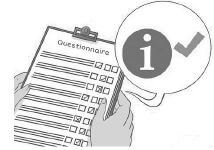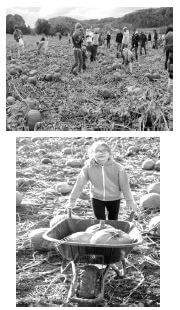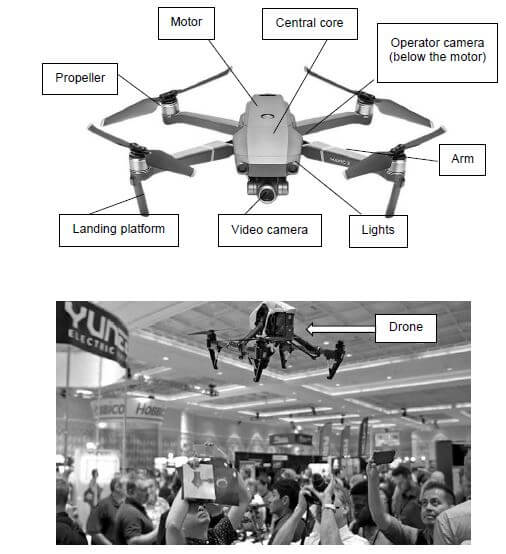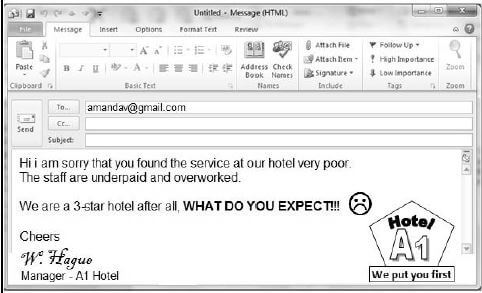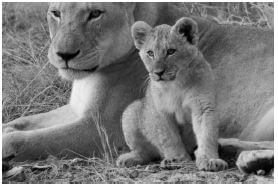Adele
TOURISM PAT GRADE 12 2021 RESOURCE PACK - TOURISM PRACTICAL ASSESSMENT TASK
TOURISM
PRACTICAL ASSESSMENT TASK
PAT 2021
GRADE 12
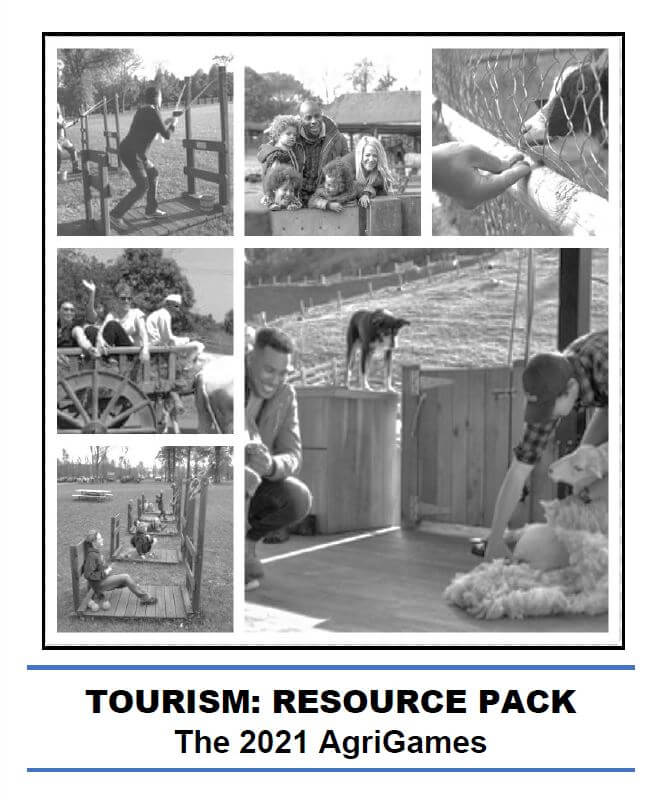
| TABLE OF CONTENTS | Page | |
| 1 | How to use the resource pack | 4 |
| 2 | Glossary | 5 |
| DAY 1 | ||
| 3 | The 4 Rs for tourism in South Africa | 8 |
| 4 | ADDENDUM A: The profile of the farm | 9 |
| 5 | ADDENDUM B: Target Market | 10 |
| 6 | ADDENDUM C: Action Plan of the 2021 AgriGames | 11 |
| 7 | ADDENDUM D: Action Plan of the 2021 AgriGames | 13 |
| 8 | ADDENDUM E: Action Plan of the 2021 AgriGames QUESTION 2.3: Outsourcing of food and beverage | 17 |
| DAY 2 | ||
| 9 | ADDENDUM F: Action Plan of the 2021 AgriGames QUESTION 3.1: The 2021 AgriGames activity | 18 |
| 10 | ADDENDUM G: Souvenirs for the 2021 AgriGames QUESTION 3.2: Branded product | 19 |
| 11 | ADDENDUM H: Action Plan of the 2021 AgriGames QUESTION 3.3: The 2021 AgriGames BarnYard | 21 |
| RESOURCE 1: Drones at events | 21 | |
| RESOURCE 2: Tourism Sector Recovery Plan Covid-19 Response | 23 | |
1. HOW TO USE THE RESOURCE PACK
The resource pack contains the resources to help you complete the questions for DAY 1 and DAY 2. 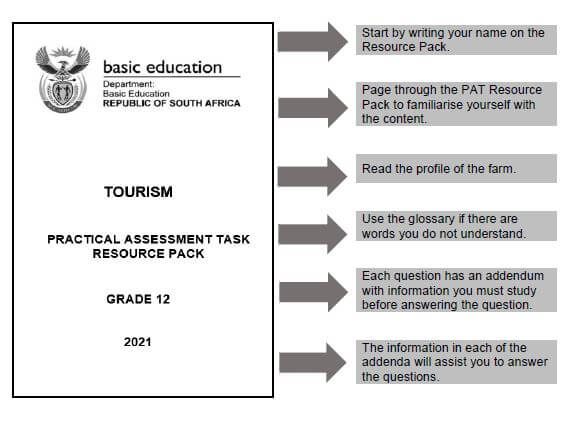
2. GLOSSARY
The glossary will help you to understand the 2021 AgriGames words/concepts used in the PAT.
| ablution | Building that houses bathing and toilet facilities |
| AgriGames | An event where participants compete in various unique games created or designed around a farm, using farming equipment, farm animals and farm property |
| agritourism | A commercial business on a working farm, a farm or an agricultural plant for visitors that provides supplementary income for the owner; |
| air conditioner | A system for controlling the ventilation and temperature in a building or vehicle, typically to maintain a cool atmosphere in warm conditions |
| allergens | A substance/ingredient causing a negative reaction of the body, e.g. breaking out in a rash |
| amenities | Something that is intended to make life more pleasant or convenient for people in a place |
| angel investors | Also known as a private investor – an individual who provides financial backing for small start-ups or entrepreneurs, typically in exchange for ownership in the company |
| arena | A level area surrounded by seating, in which sport, entertainment and other public events are held |
| barnyard | The area of open ground found around the large farm building which usually stores grain, hay, straw, etc. for the livestock on the farm |
| berth | A fixed bed on a train or other forms of transport |
| biosecurity | Procedures or measures designed to protect the population against harmful biological or biochemical substances |
| boutique hotel | A small, stylish hotel, typically situated in a fashionable urban location |
| branding | The promotion of a particular product or company by means of advertising and creative design |
| carrying capacity | The number or quantity of people or things, which can be supported in an enclosed space, e.g. a hotel can accommodate 500 people |
| communal facilities | Facilities used or shared by everyone, e.g. gym, public toilets and braai areas |
| deserted | No longer occupied or used; abandoned, uninhabited |
| devastating | Something highly destructive or damaging |
| dietary needs | Relates to the types of food eaten in one's daily diet |
| dormitory | A large room that accommodates a number of single beds usually in a school or institution set-up |
| double sharing rooms | A room containing one large bed which sleeps two people |
| drone technology | Refers to a flying robot that can be controlled remotely |
| eco-friendly | Anything not harmful to the environment |
| ecosystem | Plants and animals living in a given area or habitat |
| en suite | A bathroom that immediately adjoins a bedroom and forms part of the same set of rooms |
| entrepreneurship | The activity of setting up a business or businesses and taking on financial risks in the hope of profit |
| equity funding | Government acts as an investor and provides funding in return for a share in the start-up business |
| executive summary | A short explanation of the key elements in the larger document |
| fast food | Frozen, preheated or pre-cooked food sold in a shop, restaurant or stall to customers, usually as takeaways |
| food and beverage supply | The process of preparing, presenting and serving food and drinks to customers |
| free-range | Livestock that roam in a natural environment with freedom of movement |
| fusion | A process of bringing together different ideas to form a single theme |
| grants | A sum of money given by government or other organisations for a particular purpose |
| harvest | The cutting or picking of mature crops at the end of the growing season |
| hotelier | A person who owns or manages a hotel |
| houseboat | A boat that is used as a dwelling/home |
| hub | The centre of an activity |
| immigration | The place at an airport or at the border of a country where government officials check the documents of people entering that country |
| incentive | A reward that makes an employee want to work harder |
| innovative | Introducing new ideas; very original and creative in thinking |
| integrating | Combining one thing with another to form a whole |
| interaction | Communication or direct involvement with someone or something |
| kitchenette | A small kitchen or part of a room equipped and set up as a kitchen |
| live streaming | Transmit or receive live video and audio coverage of (an event) over the internet |
| local procurement | The purchasing of goods or services from a local supplier |
| logistical planning | Gathering information and putting structures in place to ensure that all arrangements run smoothly |
| logo | A symbol or other design adopted by a business/event/organisation to identify its products, uniform, vehicles, etc. |
| mementos | An object kept as a reminder of a person or event; often referred to as a souvenir |
| multigenerational travel | Family members comprising of different age groups coming together for a holiday |
| patio | A paved outdoor area adjoining a house |
| personal funding | Payments that an individual receives, whether earned or unearned, which includes wages, pensions, social security benefits and retirement benefits |
| piloting | Testing/Trying something out to see if it works |
| plunge pool | A small, deep pool that is usually part of an accommodation establishment or found at the foot of a waterfall |
| prohibited | Something that is not allowed |
| rebuild | To build (something) again after it has been damaged or destroyed |
| reignite | To restart the tourism industry after the impact of the Covid-19 pandemic |
| rejuvenate | Make (someone or something) look or feel better |
| reposition | To change the image of (a company, product, etc.) to target a new or wider market |
| respondent | The one who provides feedback on questions asked |
| roll-out | The actual occurrence (happening) of the planned activities |
| rustic | Made in a simple way and relates to the countryside |
| scullery | A small area in a kitchen used for washing dishes |
| self-funding | The full responsibility for the funding of a project |
| slogan | A catchphrase that communicates a message about the brand of the business/event |
| slow food movement | Slow food refers to a slow cooking process, using different free-range kinds of meat from grass-fed animals. It is prepared using natural ingredients, producing one's own food, and maintaining a strong level of awareness about the sources of food. The focus is on healthier food (nutrition), as well as on preserving culture and heritage as they relate to food. |
| souvenirs | Things that are purchased and kept as a reminder of a place visited, or event |
| sponsor | The person or organisation that makes the money available to fund a project |
| sponsorship | Financial support received from a person (sponsor) or organisation that pays for the costs involved in a project |
| stamina | The strength and energy required to allow a person to perform an activity for long periods of time |
| start-up | A company in the first stage of its operations |
| strenuous | Requiring or using great effort to undertake a task or activity |
| sundeck | An area that is positioned to catch the sun and is open to the sky |
| surveillance | Close observation of any movement within set boundaries of an area |
| traditional food | The food or cuisine that various cultures prepare and eat in a unique and specific way that has been handed down through many generations. It has language-specific names, local ingredients and forms part of cultural identity and heritage. |
| venture capital | Start-up companies with a potential to grow need a certain amount of investment. Wealthy investors like to invest their capital in such businesses. |
| transforming | A change in form, nature or appearance |
| unique selling point (USP) | How your own brand or product is better and different compared to that of your competitors |
3. THE 4 RS FOR TOURISM IN SOUTH AFRICA 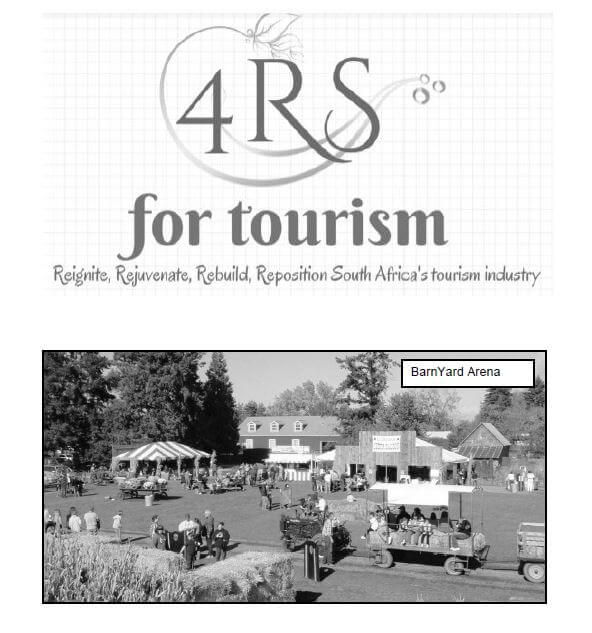
4. ADDENDUM A: THE PROFILE OF THE FARM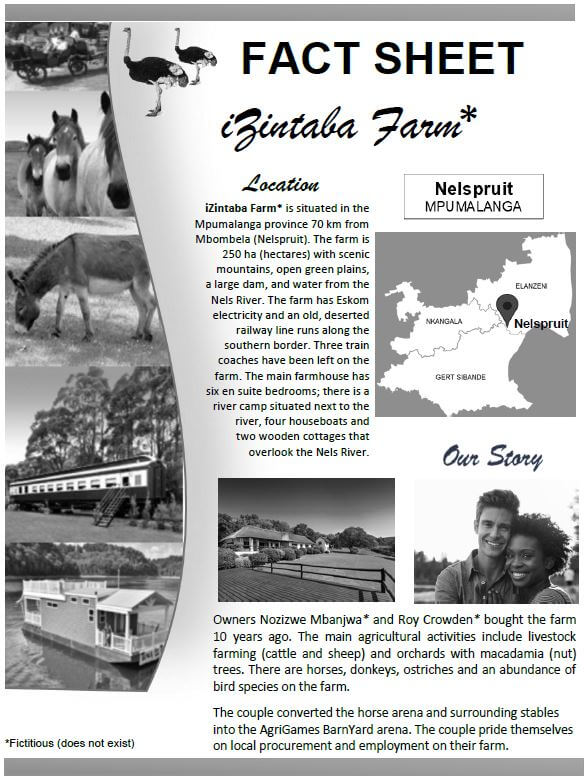
5. ADDENDUM B: TARGET MARKET
QUESTION 1: INTRODUCTION TO THE BUSINESS IDEA
The information below provides an explanation of multigenerational tourism.
Multigenerational travel, or travelling with family members, friends, or groups of all ages, is a trend that has become very popular. Many of us feel there is no time because of the pressure of work, looking after a family, trying to keep up a healthy diet and exercising when possible. [Adapted from www.trafalgar.com/real-word/multigenerational-travel] |
6. ADDENDUM C: ACTION PLAN OF THE 2021 AGRIGAMES
QUESTION 2.1: FUNDING FOR THE 2021 AGRIGAMES
Suggestion to the learner:
|
FUNDING OPPORTUNITIES FOR SMALL BUSINESSES AND START-UPS | |
Small business funding in South Africa |  |
Government funding
Depending on the industry and type of business, the applicant may qualify for funding from the following government sources: The Black Industrialists Scheme (BIS) Green Fund Tourism Transformation Fund | |
Growth Fund Technology Innovation Seed Fund National Youth Development Agency (NYDA) National Empowerment Fund (NEF) and NEF Women Fund Crowdfunding Angel investing Business incubators Bank loans Relief funding [Adapted from www.theworkspace.co.za] |
7. ADDENDUM D: ACTION PLAN OF THE 2021 AGRIGAMES
QUESTION 2.2: ACCOMMODATION CAPACITY
2.2.1 FARM-STAY COTTAGES
Waking up to nature's most musical soundtrack of birdlife, green fields and cattle grazing is a reminder of what life sounds like outside the urban environment. Two wooden farm-style cottages containing three double sharing bedrooms each overlooking the Nels River on iZintaba Farm. Feel the freedom of open spaces found within the premises of the cottages. They offer: | |||||
| | Full kitchen | | Patio | 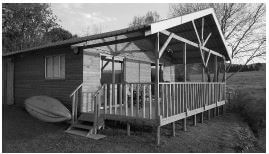 | |
| | Parking | | Linen | ||
| | Braai area | | En suite bathrooms | ||
| | Tea- and coffee-making facilities | ||||
Cost: R650 per night | |||||
Capacity: Maximum of six people per cottage | |||||
2.2.2 BOUTIQUE HOTEL
Set amongst natural surroundings with afternoon teas and cocktails on the deck in Nelspruit (Mbombela). Located within a 70 km radius of iZintaba Farm. Stay in the lap of luxury like a king with five-star treatment at your doorstep. | |||||
| | Wi-Fi | | En suite | 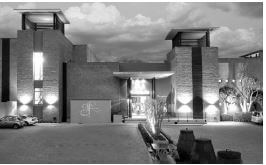 | |
| | Restaurant | | TV | ||
| | Hairdryer | | Garden | ||
| | Air conditioning | | Safe | ||
| | Braai area | ||||
Cost: From R2 200 per night, breakfast included | |||||
Capacity: 50 guests sharing in 25 luxury double rooms | |||||
2.2.3 BACKPACKER ACCOMMODATION
5 km away from iZintaba Farm and offers budget accommodation. Comfortable single bunker beds. Facilities include: | |||||
| | Communal bathroom | | Internet | 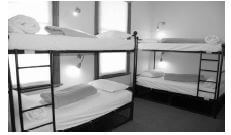 | |
| | Laundry | | Kitchen | ||
| | Parking on the premises | | Free lockers | ||
Cost: From R 157 per night | |||||
Capacity: 10 people in each of the three dormitory-style rooms | |||||
2.2.4 CARAVAN PARK
Located onsite on the iZintaba Farm, this park has 30 caravan sites (four people per caravan). Offering ablution facilities with all the conveniences expected at a top resort – clean, well maintained and serviced daily. Hot water day and night with sculleries and laundries. Facilities include: | |||||
| | Grassed stands | | Scullery | 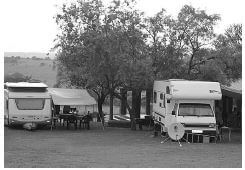 | |
| | Cellphone reception | | Wheelchair friendly | ||
| | Water points | | Braai facilities | ||
| | 220 volt electricity | | |||
Cost: From R280 per stand per night | |||||
Capacity: 120 persons | |||||
2.2.5 BED & BREAKFAST
The B&B is located 5 km from the farm. A double-storey house with six bedrooms. Unfortunately, no children below the age of 15 are allowed. Facilities include: | |||||
| | Wi-Fi | | Television |  | |
| | Parking on the premises | | En suite bathrooms | ||
| | Bar fridge in the rooms | | Dining area | ||
Cost: From R680 per night | |||||
Capacity: 12 persons (two persons per double room sharing) | |||||
2.2.6 TENT CAMPSITE UNDER THE STARS
There is nothing to compare with sleeping under the stars in the great outdoors. Unwind at your campsite after a long day spent at the AgriGames. iZintaba's campsite with its 15 camping stands is new with modern facilities. | |||||
| | Two modern ablution blocks | | Free Wi-Fi | 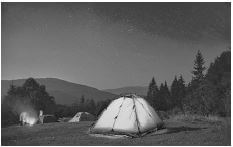 | |
| | Parking on the premises | | Braai area | ||
| | Electricity points on each stand | | Warm water | ||
Cost: R100 per stand per night | |||||
Capacity: Maximum of four persons per stand | |||||
2.2.7 SHIPPING CONTAINER ACCOMMODATION
The owners have converted four shipping containers into accommodation for the 2021 AgriGames, which is an affordable choice on the farm. Each container is fully fitted with a kitchen and en suite bathroom with accommodation for four persons. | |||||
| | Kitchen | | Shower/Toilet | 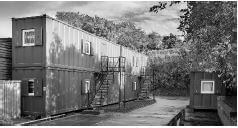 | |
| | Linen | | Braai area | ||
| | Pet friendly | | Private patio | ||
Cost: R500 per unit per night | |||||
Capacity: Four persons per shipping container | |||||
2.2.8 HALENI HOTEL ![]()
Situated 43 km away from the host farm of the 2021 AgriGames, this 5-star hotel offers a variety of amenities and facilities. It offers 46 double sharing en suite rooms with private access. Come and enjoy the luxuries of this hotel after the daily activities at the AgriGames. | |||||
| | Private access | | Three restaurants | 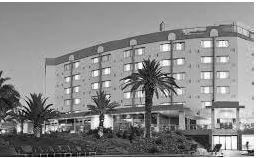 | |
| | En suite bathrooms | | Free Wi-Fi | ||
| | 24-hour room service | | Spa access | ||
| | Bar fridge in the rooms | ||||
Cost: From R5 000 per night per room | |||||
Capacity: 92 persons | |||||
2.2.9 TRAIN COACHES
The train coach accommodation is located on iZintaba Farm. There are three coaches containing three double rooms each. The bedrooms are luxurious and spacious with enough indoor and outdoor recreational areas. Facilities include: | |||||
| | Air conditioning | | Smoking rooms | 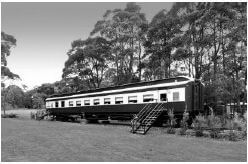 | |
| | En suite bathrooms | | Recreational area with pool | ||
| | Double rooms with television | | Bar area | ||
Cost: From R583 per person per night | |||||
Capacity: 18 persons | |||||
2.2.10 TREE-HOUSE LODGE
Located 22 km away from the host farm. Each of the four tree houses contains four bedrooms with two single beds each and a fully-equipped kitchen and entertainment area. This accommodation provides a unique experience in a natural environment. | |||||
| | Full DStv | | Fireplace | 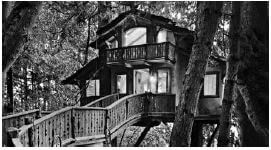 | |
| | Underfloor heating | | Free Wi-Fi | ||
| | Outside shower | | Plunge pool | ||
Cost: From R1 500 per night | |||||
Capacity: Eight per tree house (four persons in four double rooms) | |||||
2.2.11 iZINTABA HOUSEBOATS
Rent one of the four houseboats on the Nels River for the 2021 AgriGames. If you love water and want to be surrounded by nature, this will be an amazing experience. Relax in the boat with its eco-friendly reed and bamboo furniture. Each boat has two double rooms with mosquito nets, one bathroom, a sundeck and two small private balconies for each bedroom. | |||||
| | Luxury bedrooms | | Sundeck | 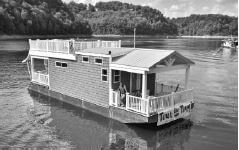 | |
| | Air conditioner | | Kitchen | ||
| | Warm and cold water | | Free Wi-Fi | ||
Cost: From R1 000 per night for the boat | |||||
Capacity: Four (two persons in two double rooms) | |||||
8. ADDENDUM E: ACTION PLAN OF THE 2021 AGRIGAMES
QUESTION 2.3: OUTSOURCING OF FOOD AND BEVERAGE
TIPS ON CREATING YOUR OWN QUESTIONNAIRE
Questionnaire question types Not all question types are ideal in every situation. This is the reason why it is important to understand the type of questionnaire you are creating first. With that information, it becomes easier to choose the right question types.
[Adapted from www.kyleads.com/blog/questionnaire] |
9. ADDENDUM F: ACTION PLAN OF THE 2021 AGRIGAMES
QUESTION 3.1: THE 2021 AGRIGAMES ACTIVITY
EXAMPLE OF AN AGRIGAMES ACTIVITY | |
NAME OF ACTIVITY | PUMPKIN HARVEST TIME |
The duration of the activity | 1 hour |
The age/weight restriction for participation | 16–55 years |
The description of the activity
|
|
The safety precautions for participating in the activity |
|
| The rules for responsible tourist behaviour (Take note to protect flora and fauna; participation in activities and events must ensure sustainability in every way possible.) |
|
10. ADDENDUM G: SOUVENIRS FOR THE 2021 AGRIGAMES
QUESTION 3.2: BRANDED PRODUCT
In this question you are expected to design a branded product for the 2021 AgriGames. This product must be made by the local community and will be sold as souvenirs to visitors to the 2021 AgriGames.
|
What is a souvenir? An item given, kept or bought as a reminder of a place visited, an occasion, an event, etc. Also called a 'memento' or 'keepsake'. Souvenirs is an important component of the tourist's experience, with most tourists taking back mementos and souvenirs as evidence of the places they have visited. People like to be reminded of special moments in their lives. |
LOGO |
EXAMPLES OF BRANDED PRODUCTS FOR SOUTH AFRICA |
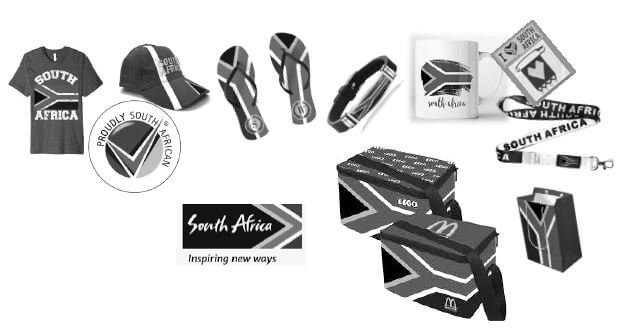 | ||
Checklist for designing a branded product for the 2021 AgriGames | ||
The logo of the 2021 AgriGames | ||
The drawing is clear and includes the logo | ||
An explanation of why the product is eco-friendly | ||
An explanation of the suitability of the product as a souvenir | ||
11. ADDENDUM H: ACTION PLAN OF THE 2021 AGRIGAMES |
QUESTION 3.3: THE 2021 AGRIGAMES BARNYARD
RESOURCE 1
DRONES AT EVENTS |
|
10 INNOVATIVE WAYS TO USE DRONES AT EVENTS |
1. PHOTOS | 2. VIDEOS |
3. LIVE STREAMING | 4. SURVEILLANCE AND SECURITY |
5. LOGISTICAL MONITORING | 6. VISUAL SHOWS |
7. RACING FOR ENTERTAINMENT | 8. SPONSORSHIP |
9. MOBILE HOTSPOTS | 10. DELIVERY |
[Adapted from www.attendstar.com] | |
RESOURCE 2
TOURISM SECTOR RECOVERY PLAN COVID-19 RESPONSE (AUGUST 2020) |
OVERVIEW [Adapted from Tourism Sector Recovery Plan Covid-19 Response, August 2020] |
TOURISM PAT GRADE 12 2021 DAY 1 - TOURISM PRACTICAL ASSESSMENT TASK
TOURISM
PRACTICAL ASSESSMENT TASK
PAT 2021
GRADE 12
DAY 1
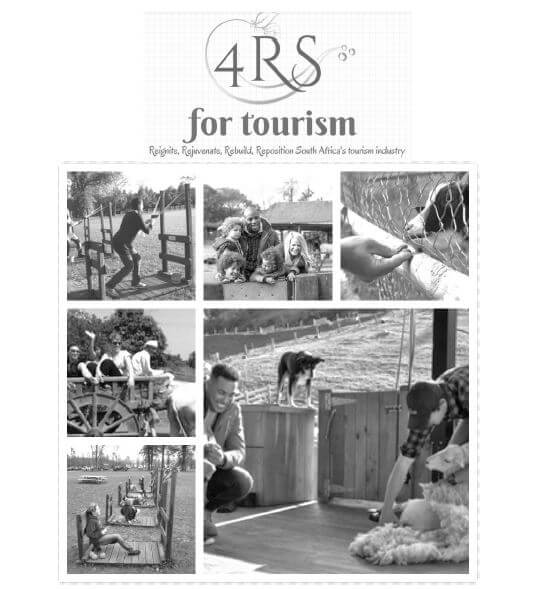 |
BACKGROUND |
As the world faces the devastating consequences of the Covid-19 pandemic, the tourism sector is among those severely affected. Travel is down, fear is up and the future is uncertain. |
What is a start-up? A start-up is a young company with a limited budget, founded by one or more entrepreneurs to develop a unique product or service. Start-ups use their own funding and also source (get) additional funding from public and private investors. |
SCENARIO |
You, as a Grade 12 Tourism learner, have come up with a new business idea, called the 2021 AgriGames. The 2021 AgriGames is the fusion of agriculture tourism with either events tourism, adventure tourism or sports tourism to create a new, unique tourism experience. *Fictitious (does not exist) |
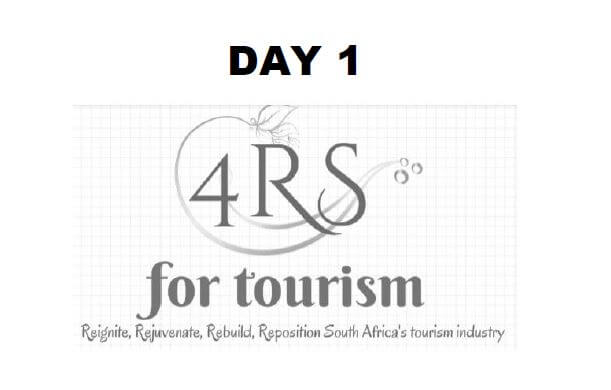
TIME: 4 hours (2 x 2 hours)
MARKS: 50
INSTRUCTIONS AND INFORMATION TO LEARNERS |
For the 2021 PAT you are required to develop a planning portfolio where you expand on the 2021 AgriGames business idea.
The table on the next page shows the suggested times and references to be used for each question. |
DAY 1: QUESTIONS 1 AND 2 | |||||
RESOURCE PACK | |||||
Content | Marks | Suggested time | Addendum | Page no. | |
QUESTION 1 | Introduction to the business idea | 20 | 1½ hours | A B H | 9 10 21 |
QUESTION 2 | Action Plan of the 2021 AgriGames | ||||
QUESTION 2.1 | Funding for the 2021 AgriGames | 5 | 30 minutes | A C | 9 11 12 |
BREAK | 30 minutes | ||||
QUESTION 2.2 | Accommodation capacity | 15 | 1 hour 15 min. | A D | 9 13 |
QUESTION 2.3 | Outsourcing of food and beverage | 10 | 45 minutes | A E | 9 17 |
TOTAL | 50 | 4 hours | |||
QUESTION 1: | INTRODUCTION TO THE BUSINESS IDEA | (20 marks) |
Use the scenario and refer to ADDENDA A, B and H of the RESOURCE PACK to answer this question. | ||
To introduce the details of your business idea, write FIVE paragraphs about the 2021 AgriGames.
|
QUESTION 2: | ACTION PLAN OF THE 2021 AGRIGAMES | (30 marks) |
It is essential that all logistical planning must be in place for the successful roll-out of the 2021 AgriGames.
|
QUESTION 2.1 | Funding for the 2021 AgriGames | (5 marks) |
| Refer to ADDENDA A and C of the RESOURCE PACK to answer this question. | ||
Choose ONE funding option and explain why it is the most suitable option for the 2021 AgriGames event. | ||
QUESTION 2.2 | Accommodation capacity for the 2021 AgriGames | (15 marks) |
| Refer to ADDENDA A and D of the RESOURCE PACK to answer this question | ||
2.2.1 Select FIVE of the most appropriate types of accommodation suitable for the multigenerational group (consisting of six people) for the four days of the 2021 AgriGames. |
| ACCOMMODATION CAPACITY | ||||
TYPE OF ACCOMMODATION | Number of beds available | Reasons why each accommodation type is suitable for multigenerational group | ||
A | ||||
B | ||||
C | ||||
D | ||||
E | ||||
(10) | ||||
2.2.2 Based on the information in the table in QUESTION 2.2.1, draw a bar graph to indicate the accommodation capacity.
|
QUESTION 2.3 | Outsourcing of food and beverage | (10 marks) . |
| Refer to ADDENDA A, E and the glossary in the RESOURCE PACK to answer this question | ||
Local entrepreneurs, community organisations and businesses will provide the food and beverage services at the 2021 AgriGames. Those interested in providing food and beverage services must complete the questionnaire posted on the 2021 AgriGames website. |
Develop die questionnaire to be completed by local entrepreneurs, community organisations and businesses interested to provide food and beverage services at the 2021 AgriGames.
|
| (10) |
TOTAL DAY 1: | 50 |
Refer to the assessment criteria for each question below, which will help you to structure your responses.
ASSESSMENT INSTRUMENT FOR DAY 1 (For use by the teacher and moderator)
Name of learner: | Grade 12 |
Your answer will be assessed using the assessment criteria below. Use the criteria to plan your responses accordingly.
QUESTION 1: INTRODUCTION TO BUSINESS IDEA | (20 marks) |
Criteria | 0 | 1–2 | 3 | 4 | T | M |
1. Explanation of the 2021 AgriGames concept | No attempt was made to explain the 2021 AgriGames business idea. | A short, superficial explanation of the 2021 AgriGames business idea with insufficient information is given. The explanation is incomplete. | An acceptable explanation with sufficient information on the 2021 AgriGames business idea is given. The explanation may leave the reader with some questions that need to be clarified. | An excellent, well-structured explanation with sufficient information on the 2021 AgriGames business idea is given. The explanation gives the reader a complete understanding of the business idea. | ||
2. The different reasons for hosting the 2021 AgriGames | No attempt was made to give different reasons for hosting the 2021 AgriGames. | The different reasons given are unconvincing or incomplete or do not give a clear understanding. | The different reasons given are acceptable, complete and give a fair understanding. The reasons may leave the reader with some questions that need to be clarified. | The different reasons given are exceptional, complete with excellent motivation for hosting the 2021 AgriGames. | ||
3. The suitability of the 2021 AgriGames location | Unable to explain the suitability of the 2021 AgriGames location. | A superficial, incomplete explanation of the suitability of the location for the 2021 AgriGames is given. | An acceptable explanation of the suitability of the location for the 2021 AgriGames is given. The explanation may leave the reader with some questions that need to be clarified. | An excellent, outstanding explanation of the suitability of the location for the 2021 AgriGames is given. | ||
4. Reasons why the event targets multigenerational visitors and participants | No attempt was made to give reasons why the event targets multigenerational visitors and participants. | The reasons given are unconvincing or incomplete or do not give a clear understanding. | The reasons given are acceptable, complete and give a fair understanding. The reasons may leave the reader with some questions that need to be clarified. | The reasons given are exceptional, complete with excellent motivation why the event targets multigenerational visitors and participants. | ||
5. Ways in which the event will be advertised or promoted | Unable to explain the ways in which the event will be advertised or promoted. | A superficial, incomplete explanation of how the event will be advertised or promoted is given. | An acceptable explanation of how the event will be advertised or promoted is given. | An excellent, outstanding explanation of how the event will be advertised or promoted is given. | ||
TOTAL: | ||||||
QUESTION 2.1: FUNDING FOR THE 2021 AGRIGAMES | (5 marks) |
Your answer will be assessed using the assessment criteria below. Use the criteria to plan your responses accordingly. |
Criteria | 0 | 1–2 | 3–4 | 5 | T | M |
Explanation why the chosen funding option is the most suitable for the 2021 AgriGames | No funding option was chosen. OR No attempt was made to explain why the chosen funding option is the most suitable for the 2021 AgriGames. | A short, superficial explanation why the chosen funding option is the most suitable for the 2021 AgriGames is given. The explanation is incomplete. | An acceptable explanation with sufficient information why the chosen funding option is the most suitable for the 2021 AgriGames is given. The explanation may require clarity with certain questions around the link to the 2021 AgriGames. | An excellent, well-structured explanation with sufficient reasons why the chosen funding option is the most suitable for the 2021 AgriGames is given. The explanation gives complete understanding why this option was chosen specifically for the 2021 AgriGames. |
QUESTION 2.2: ACCOMMODATION CAPACITY FOR THE 2021 AGRIGAMES | (15 marks) |
Your answer will be assessed using the assessment criteria below. Use the criteria to plan your responses accordingly. |
Criteria (10 marks) | 0 | 1 | 2 | 3 | T | M |
2.2.1 COMPLETE THE TABLE – Select FIVE appropriate types of accommodation for the multigenerational group. | Unable to select FIVE appropriate types of accommodation. | FIVE types of accommodation are selected but none of the options are appropriate or suitable. | FIVE types of accommodation are selected, however only some of the options are appropriate or suitable. | FIVE types of accommodation are selected. All of the options appropriate or suitable. | ||
Number of beds available | Unable to calculate the total number of beds available. | The calculation of number of beds is incomplete or incorrect. | The calculation of the number of beds is correct but incomplete – some information was omitted. | The correct number of beds are calculated for each of the types of accommodation. | ||
Reasons why each accommodation is suitable for the 2021 AgriGames | No attempt was made to give reasons why each accommodation is suitable for the 2021 AgriGames. | The reasons given are unconvincing or incomplete or do not give a clear understanding. | The reasons given are acceptable, complete and give a fair understanding. The reasons may leave the reader with some questions that need to be clarified. | The reasons given are exceptional, complete with excellent motivation why each accommodation is suitable for the 2021 AgriGames. | ||
TOTAL: | ||||||
Criteria (5 marks) | 0 | 1–2 | 3–4 | 5–6 | T | M |
2.2.2 Draw a bar graph to indicate the accommodation capacity. | Unable to draw a bar graph to indicate the accommodation capacity. | A graph is drawn that indicates the accommodation capacity, but the incorrect type of graph was used and some information/data on the graph is incorrect. | A bar graph is drawn that indicates the accommodation capacity, but some information/data on the graph is incorrect. | A bar graph is drawn that indicates the accommodation capacity and all information/data displayed on the graph is correct. |
QUESTION 2.3: OUTSOURCING OF FOOD AND BEVERAGE FOR THE 2021 AGRIGAMES | (10 marks) |
Your answer will be assessed using the assessment criteria below. Use the criteria to plan your responses accordingly. |
Criteria | 0 | 1–3 | 4–7 | 8–10 | T | M |
Develop the questionnaire to be completed by local entrepreneurs, community organisations and businesses who are interested in providing food and beverage services at the 2021 AgriGames. | Unable to develop a questionnaire. | A questionnaire was developed, but only contains ONE type of question throughout. AND/OR Includes only 1 or 2 of the FIVE questions required that will gather the information correctly. | A questionnaire was developed, but only contains TWO types of questions. AND/OR Includes only 3 or 4 of the FIVE questions required that will gather the information correctly. | A questionnaire was developed that contains THREE different types of questions and includes all FIVE of the required questions that will gather the information correctly. | ||
GRAND TOTAL DAY 1: 50 MARKS | ||||||
______________________________________ ______________________________________
Signature: Teacher Date:
______________________________________ ______________________________________
Signature: Moderator Date:
TOURISM PAT GRADE 12 2021 DAY 2 - TOURISM PRACTICAL ASSESSMENT TASK
TOURISM
PRACTICAL ASSESSMENT TASK
PAT 2021
GRADE 12
DAY 2
 |
BACKGROUND |
As the world faces the devastating consequences of the Covid-19 pandemic, the tourism sector is among those severely affected. Travel is down, fear is up and the future is uncertain. |
What is a start-up? A start-up is a young company with a limited budget, founded by one or more entrepreneurs to develop a unique product or service. Start-ups use their own funding and also source (get) additional funding from public and private investors. |
SCENARIO |
You, as a Grade 12 Tourism learner, have come up with a new business idea, called the 2021 AgriGames. The 2021 AgriGames is the fusion of agriculture tourism with either events tourism, adventure tourism or sports tourism to create a new, unique tourism experience. *Fictitious (does not exist) |
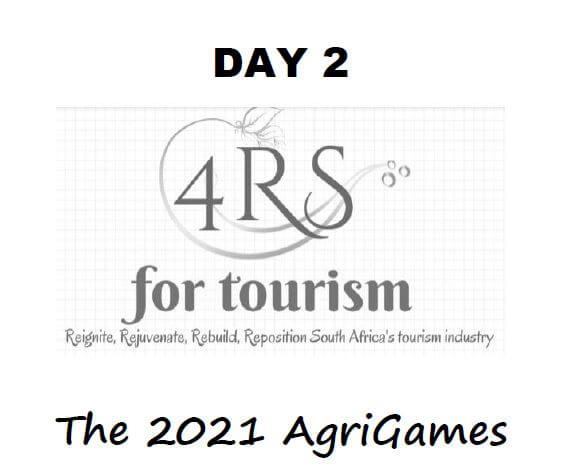
TIME: 4 hours (2 hours + 2 hours)
MARKS: 50
INSTRUCTIONS AND INFORMATION TO LEARNERS |
For the 2021 PAT you are required to develop a planning portfolio where you expand on the 2021 AgriGames business idea.
The table on the next page shows the suggested times and references to be used for each question. |
DAY 2: QUESTION 3 | |||||
RESOURCE PACK | |||||
Content | Marks | Suggested time | Addendum | Page no. | |
QUESTION 3 | Action Plan of the 2021 AgriGames (continued) | ||||
QUESTION 3.1 | The 2021 AgriGames activity | 20 | 1½ hours | A F | 9 18 |
QUESTION 3.2 | Souvenirs for the 2021 AgriGames | 10 | 1 hour | A G | 9 19 |
BREAK: 30 MINUTES | |||||
QUESTION 3.3 | The 2021 AgriGames BarnYard | 20 | 1½ hours | A H | 9 21 |
TOTAL | 50 | 4 hours | |||
QUESTION 3: ACTION PLAN OF THE 2021 AGRIGAMES | (50 marks) |
In the action plan for the 2021 AgriGames you need to consider each of the following elements: QUESTION 3.1: The 2021 AgriGames activity |
QUESTION 3.1 | The 2021 AgriGames activity | (20 marks) |
| Refer to ADDENDA A and F of the RESOURCE PACK to answer this question. | ||
The activities at the event aim to challenge the participants' stamina (strength) and their sense of adventure. |
Design a competitive activity that will include one or more farm activities, e.g. the picking of nuts, bird spotting, at the 2021 AgriGames. The activity/activities may include the use of farm equipment (wheelbarrow, tractor, spade, etc.)
|
(20) |
QUESTION 3.2 | Souvenirs for the 2021 AgriGames | (10 marks) |
| Refer to ADDENDA A and G of the RESOURCE PACK to answer this question. | ||
As part of branding for the 2021 AgriGames, the local community will be involved in manufacturing souvenirs for the event. |
On an A4-page, design an eco-friendly, branded product for the 2021 AgriGames. When designing the product, keep in mind it must be something that visitors will want to buy as a reminder of the event.
|
(10) |
QUESTION 3.3 | The 2021 AgriGames BarnYard | (20 marks) |
Refer to ADDENDA A and H of the RESOURCE PACK to answer this question. | ||
The 2021 AgriGames will use a central area on the farm, called the AgriGames BarnYard, for registration, ticket sales, entertainment, evening programmes, media, big screen live streaming of the activities and food and beverage facilities. | |
In a dialogue format, prepare your responses to the questions received from the media. | |
EXAMPLE: | |
Media question | When and where will the 2021 AgriGames be held? |
Your response | The 2021 AgriGames will be held from 23–26 September 2021 on the iZintaba Farm near Mbombela in Mpumalanga. |
Questions received from the media:
|
(20) |
TOTAL DAY 2 : | 50 |
Refer to the assessment criteria for each question below, which will help you to structure your responses.
ASSESSMENT INSTRUMENT FOR DAY 2 (For use by the teacher and moderator)
Name of learner: | Grade 12 |
Your answer will be assessed using the assessment criteria below. Use the criteria to plan your responses accordingly.
QUESTION 3.1: | THE 2021 AGRIGAMES ACTIVITY | (20 marks) |
Criteria | 0 | 2–4 | 5–6 | 7–8 | T | M |
1. Design a competitive activity that includes one or more farm activities. | No attempt was made to design a competitive activity that includes one or more farm activities. | A superficial competitive activity that includes one or more farm activities has been designed but contains very little substance. | An acceptable competitive activity that will include one or more farm activities has been designed with moderate substance. The details may leave the reader with some questions about the activity. | An excellent, well-structured, competitive activity with sufficient information was designed. The activity creates a sense of excitement and anticipation. | ||
Criteria | 0 | 1–3 | 4 | 5 | T | M |
2. Details of the activity, name, duration, age, weight, etc. | No details of the activity, such as name, duration, age, weight, etc. is given. | Very little details of the activity are given. Some essential information, such as name, duration, age, weight, etc. is omitted. The details may leave the reader with some questions that need to be clarified. | Most of the details of the activity are given. Essential information, such as name, duration, age, weight, etc. is included. | All details of the activity are given. Essential information, such as name, duration, age, weight, etc. is included. Additional detailed information is given that leaves no room for misinterpretation. | ||
Criteria | 0 | 1–2 | 3 | 4 | T | M |
3. Safety regulations for participation in the activity | Unable to explain the safety regulations for participation in the activity. | A superficial, incomplete explanation of safety regulations for participation in the activity is given. The explanation has very little substance. | An acceptable explanation of the safety regulations for participation in the activity is given. The explanation may leave the reader with questions that need to be clarified. | An excellent, outstanding, innovative explanation of the safety regulations for participation in the activity is given. All applicable safety aspects are included, e.g. Covid-19 safety protocols. | ||
Criteria | 0 | 1 | 2 | 3 | T | M |
4. Rules for responsible tourist behaviour | Unable to explain the rules for responsible tourist behaviour. | A superficial, incomplete explanation of the rules for responsible tourist behaviour is given. Explanation has very little substance. | An acceptable explanation of the rules for responsible tourist behaviour is given. The explanation may leave the reader with questions that need to be clarified. | An excellent, outstanding, innovative explanation of the rules for responsible tourist behaviour is given. Additional information to strengthen the explanation is given. | ||
TOTAL: | ||||||
QUESTION 3.2: SOUVENIRS FOR THE 2021 AGRIGAMES | (10 marks) |
Your answer will be assessed using the assessment criteria below. Use the criteria to plan your responses accordingly. |
Criteria | 0 | 1–2 | 3 | 4 | T | M |
1. Design an eco-friendly, branded product for the 2021 AgriGames. Logo, clear drawing with logo | No attempt was made to design an eco friendly, branded product for the 2021 AgriGames. | A product was designed. The product is unsuitable, | An acceptable eco-friendly, branded product with a logo was designed. The product is suitable to be sold as a souvenir of the event. | An excellent, branded, eco-friendly product was designed that most visitors and participants will want to buy as a reminder of the event. The product is attractive, innovative and interesting and has a unique selling point that makes it stand out from other souvenirs. |
Criteria | 0 | 1 | 2 | 3 | T | M |
2. Explain why the product can be considered eco-friendly | No attempt was made to explain why the product can be considered eco-friendly. | A short, superficial explanation why the product can be considered eco-friendly, is given. The explanation is incomplete. | An acceptable explanation with information why the product can be considered eco-friendly, is given. The explanation may leave the reader with some questions that need to be clarified. | An excellent, well-structured explanation with sufficient reasons why the product can be considered eco-friendly, is given. Additional information is included that strengthens the explanation. |
Criteria | 0 | 1 | 2 | 3 | T | M |
3. Explain the suitability of the product as a souvenir. | No attempt was made to explain why the product is suitable to be sold as a souvenir at the event. | A short, superficial explanation why the product is suitable to be sold as a souvenir at the event, is given. The explanation is incomplete. | An acceptable explanation why the product is suitable to be sold as a souvenir at the event, is given. The explanation may leave the reader with questions that need to be clarified. | An excellent, well-structured explanation with sufficient reasons why the product is suitable to be sold as a souvenir at the event, is given. Additional information is included that strengthens the explanation. |
QUESTION 3.3: THE 2021 AGRIGAMES BARNYARD | (20 marks) |
Your answer will be assessed using the assessment criteria below. Use the criteria to plan your responses accordingly. |
Criteria | 0 | 1–2 | 3 | 4 | T | M |
PREPARE FOR THE MEDIA INTERVIEW. | Unable to explain the purpose of the AgriGames BarnYard. | A short, superficial explanation is given without much substance. Very little reference to the purpose. Very little information is provided that will be useful to the media. | An acceptable, complete explanation is given that will be useful to the media. The purpose is stated clearly. | An excellent, enthusiastic explanation is given with enough elaboration on the purpose to be useful to the media. The explanation can be used verbatim by the media with little or no additions. |
Criteria | 0 | 1–2 | 3 | 4 | T | M |
2. What visitors can expect from the evening programmes/ entertainment in the AgriGames BarnYard | Unable to explain what visitors can expect from the evening programmes/ entertainment. | An average explanation is given. The response does not evoke excitement, nor will visitors be enticed to visit the event. | An acceptable explanation was given that will be useful to the media. Some information was omitted. | A detailed, enthusiastic explanation is given with enough interesting facts on the evening programmes to be useful to the media. The responses create a sense of excitement. |
Criteria | 0 | 1–2 | 3 | 4 | T | M |
3. Why big screen live streaming will be used at the AgriGames BarnYard | Unable to explain why big screen live streaming will be used at the AgriGames BarnYard. | The reasons given are unconvincing or incomplete or do not give a clear understanding. | The reasons given are acceptable and give a fair understanding. The reasons may leave the reader with some questions that need to be clarified. | The reasons given are complete with an excellent explanation why big screen live streaming will be used at the AgriGames BarnYard. The responses create a sense of excitement. |
Criteria | 0 | 1–2 | 3 | 4 | T | M |
4. How drone technology is going to be beneficial for the AgriGames BarnYard | Unable to explain how drone technology is going to be beneficial for the AgriGames BarnYard. | The explanation given is vague or incomplete or does not give a clear understanding of how drone technology is going to be beneficial for the AgriGames BarnYard. | The explanation given is acceptable and gives a fair understanding of how drone technology is going to be beneficial for the AgriGames BarnYard. | The explanation given is complete and gives excellent understanding of how dronetechnology is going to be beneficial for the AgriGames BarnYard. The responses create a sense of excitement. |
Criteria | 0 | 1–2 | 3 | 4 | T | M |
5. Covid-19: How the 2021 AgriGames will help to reignite, rejuvenate, rebuild and reposition South Africa's tourism industry | Unable to explain how the 2021 AgriGames will help to reignite, rejuvenate, rebuild and reposition South Africa's tourism industry. | The explanation is vague or incomplete or does not give a clear understanding of how the 2021 AgriGames will help to reignite, rejuvenate, rebuild and reposition South Africa's tourism industry. | The explanation given is acceptable and gives a fair understanding of how the 2021 AgriGames will help reignite, rejuvenate, rebuild and reposition South Africa's tourism industry. | The explanation given is complete and gives excellent understanding of how the 2021 AgriGames will help to reignite; rejuvenate; rebuild and reposition South Africa's tourism industry. | ||
TOTAL: | ||||||
| GRAND TOTAL DAY 2: 50 MARKS | ||||||
______________________________________ ______________________________________
Signature: Teacher Date:
______________________________________ ______________________________________
Signature: Moderator Date:
MUSIC PAPER 1 GRADE 12 QUESTIONS - NSC PAST PAPERS AND MEMOS FEBRUARY/MARCH 2018
MUSIC
PAPER 1
GRADE 12
NSC PAST PAPERS AND MEMOS
FEBRUARY/MARCH 2018
INSTRUCTIONS AND INFORMATION
- This question paper consists of FIVE sections, namely SECTIONS A, B, C, D and E.
- SECTIONS A and B are COMPULSORY.
- SECTION C: WESTERN ART MUSIC (WAM), SECTION D: JAZZ and SECTION E: INDIGENOUS AFRICAN MUSIC (IAM) are choice questions. Answer only ONE of these sections (SECTION C or D or E).
- Write ALL music notation in SECTION A in pencil and all written text in blue or black ink on this question paper.
- Answer SECTION B and SECTION C or D or E in blue or black ink in the ANSWER BOOK provided.
- Number the answers correctly according to the numbering system used in this question paper.
- The last page of this question paper is manuscript paper intended for rough work. Candidates may remove this page.
- Candidates may NOT have access to any musical instrument for the duration of this examination.
- Candidates must take note of the mark allocation of each question in order to provide enough information in their answer.
- Write neatly and legibly.
Marking Grid
SECTION | QUESTION | MARKS | MARKER | MODERATOR |
A: THEORY OF MUSIC (COMPULSORY) | 1 | 20 | ||
2 | 15 | |||
3 | 10 | |||
4 | 15 | |||
SUBTOTAL | 60 |
|
| |
AND | ||||
B: GENERAL (COMPULSORY) | 5 | 20 | ||
SUBTOTAL | 20 |
|
| |
AND | ||||
C: WAM | 6 | 10 | ||
7 | 5 | |||
8 | 5 | |||
9 | 5 | |||
10 | 15 | |||
SUBTOTAL | 40 |
|
| |
OR | ||||
D: JAZZ | 11 | 10 | ||
12 | 5 | |||
13 | 5 | |||
14 | 5 | |||
15 | 15 | |||
SUBTOTAL | 40 |
|
| |
OR | ||||
E: IAM | 16 | 10 | ||
17 | 5 | |||
18 | 5 | |||
19 | 5 | |||
20 | 15 | |||
SUBTOTAL | 40 |
|
| |
| ||||
GRAND TOTAL | 120 |
|
| |
QUESTIONS
SECTION A: THEORY OF MUSIC (COMPULSORY) (90 minutes)
- Answer QUESTION 1
- AND QUESTION 2.1 OR 2.2
- AND QUESTION 3.1 OR 3.2
- AND QUESTION 4.1 OR 4.2.
Answer the questions in the spaces provided on this question paper.
QUESTION 1 (25 minutes)
Study the extract from Send in the Clowns by Stephen Sondheim below and answer the questions that follow.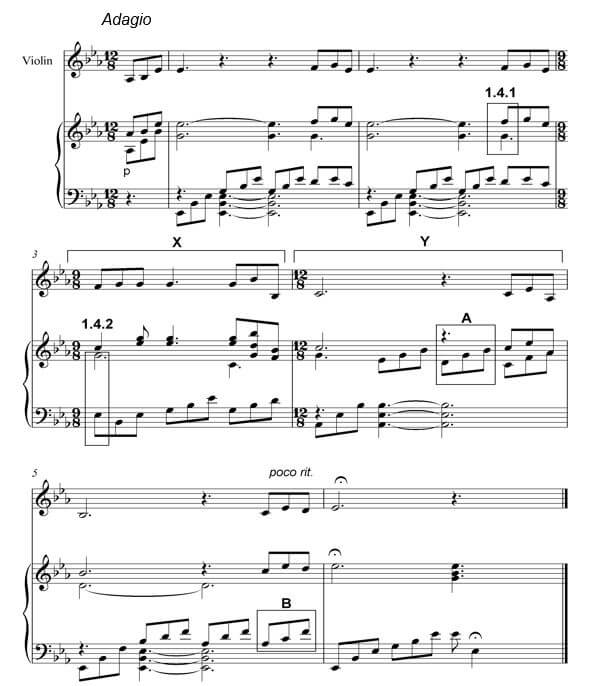
1.1 Name the key of the work.
__________________________________________ (1)
1.2 What is the relative minor of the main key?
__________________________________________ (1)
1.3 Transpose the first four notes of the violin part a major third higher on the given stave below. Use a new key signature.(2)
1.4Name the intervals at 1.4.1 and 1.4.2 according to type and distance.
1.4.1 _____________________________________
1.4.2 _____________________________________ (2)
1.5
Name the triads at A and B according to type and position, for example Major, second inversion. (Consider ONLY the notes in the block.)
A: ______________________________________
B: _______________________________________ (2)
1.6 Rewrite the violin part at X using half the note values. Insert the new time signature.(2)
1.7 Rewrite the violin part at Y in the corresponding simple quadruple time, using the alto clef.(3)
1.8 What is the meaning of the Italian term adagio?
___________________________________________(1)
1.9 In which scale/mode is the melody below written?
_________________________________________________(1)
1.10 Write the melodic form of the B minor scale, descending, using the alto clef. Write without a key signature, use semibreves and mark the semitones.(3)
1.11 Complete the fragment by writing sequences of motif (a) in bars 2 and 3.(2)
[20]
QUESTION 2 (25 minutes)
Answer EITHER QUESTION 2.1 OR QUESTION 2.2.
2.1 Complete the opening motif below to form a twelve-bar melody in ternary form for any single-line melodic instrument of your choice. Name the instrument for which you are writing. Indicate the tempo and add dynamic and articulation marks.
Instrument:______________________________________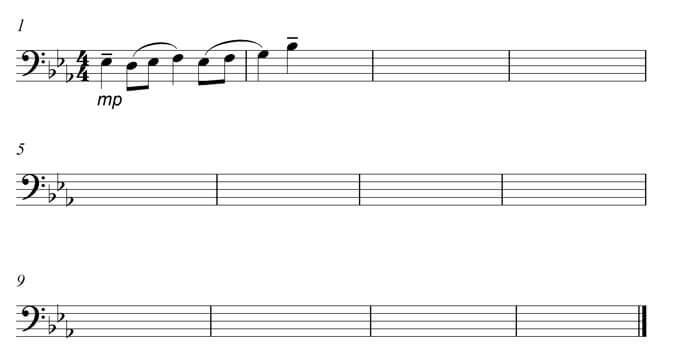
The melody will be marked according to the following criteria:
| DESCRIPTION | MARK ALLOCATION | CANDIDATE'S MARKS |
| Form and cadential points | 3 | |
| Correctness Note stems, beats per bar, accidentals, spacing | 2 | |
| Quality Suitability, dynamics, articulation, tempo indication, musicality | 10 | |
| TOTAL | 15 |
[15]
OR
2.2 Complete the opening motif below to form a twelve-bar melody in ternary form for any single-line melodic instrument of your choice. Name the instrument for which you are writing. Indicate the tempo and add dynamic and articulation marks.
Instrument:____________________________________________________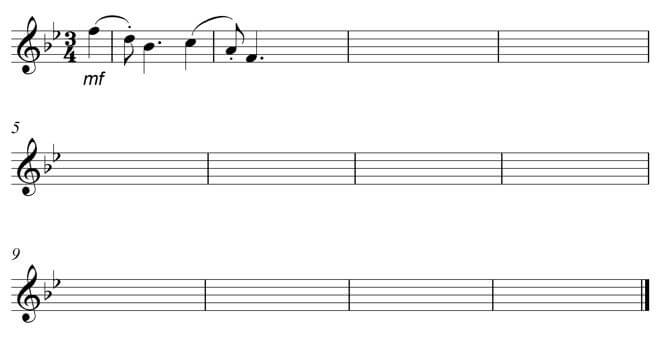
The melody will be marked according to the following criteria:
| DESCRIPTION | MARK ALLOCATION | CANDIDATE'S MARKS |
| Form and cadential points | 3 | |
| Correctness Note stems, beats per bar, accidentals, spacing | 2 | |
| Quality Suitability, dynamics, articulation, tempo indication, musicality | 10 | |
| TOTAL | 15 |
[15]
QUESTION 3 (10 minutes)
Answer EITHER QUESTION 3.1 OR QUESTION 3.2.
3.1 Study the extract below and answer the questions that follow.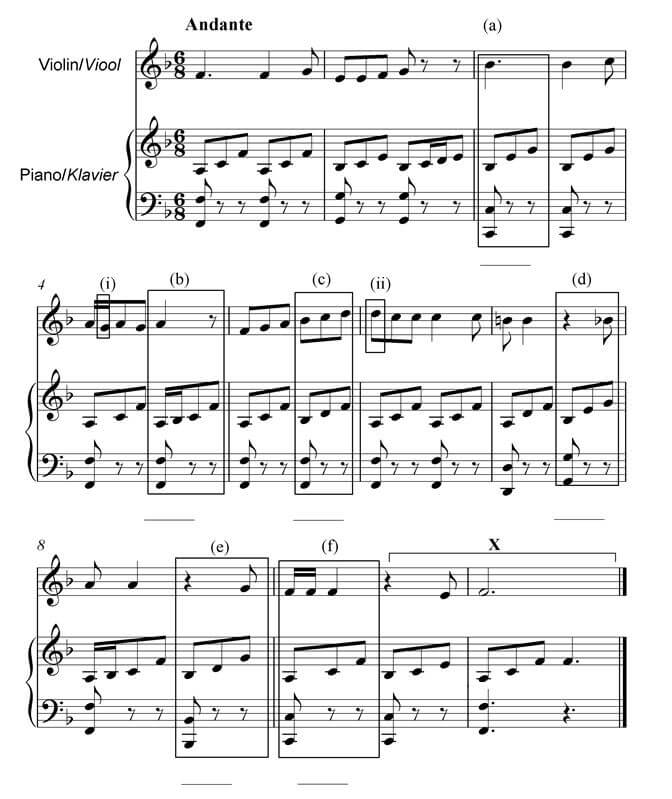
3.1.1 Identify the chords from (a)–(f) and figure them on the score, e.g. iiib/iii6. (6)
3.1.2 Name the type of non-chordal notes at (i) and (ii).
(i) _______________________________________
(ii) _______________________________________(2)
3.1.3 Identify the cadence at X. Write down the chord progression and the name of the cadence.
Chord progression: _______________________________
Cadence: _______________________________(2) [10]
OR
3.2 Study the extract below and answer the questions that follow.
3.2.1 Identify the chords from (a)–(f) and figure them on the score, e.g. B/F#. (6)
3.2.2 Name the type of non-chordal notes at (i) and (ii).
(i)_______________________________________
(ii)_______________________________________(2)
3.2.3 Identify the cadence at X. Write down the chord symbols and the name of the cadence.
Chord symbols: ____________________________________
Cadence: ____________________________________ (2) [10]
QUESTION 4 (30 minutes)
Answer EITHER QUESTION 4.1 OR QUESTION 4.2.
4.1 Complete the four-part vocal harmonisation below by adding the alto, tenor and bass parts.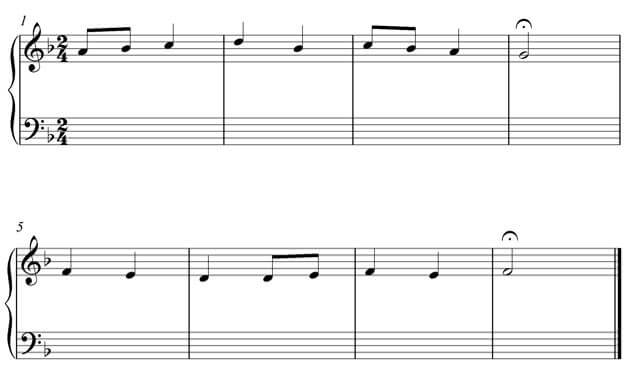
The harmonisation will be marked according to the following criteria:
| DESCRIPTION | MARK ALLOCATION | CANDIDATE'S MARKS |
| Chord progression Choice of chords, correct use of cadecence | 12 | |
| Correctness Notation, doubling, spacing, voice leading | 14 | |
| Quality Musicality, non-chordal notes, awareness of style, creativity | 4 | |
| 30/2 | ||
| TOTAL | 15 |
[15]
OR
4.2 Complete the piece below by adding suitable harmonic material in the open stave. Continue in the style suggested by the given material in bar 1.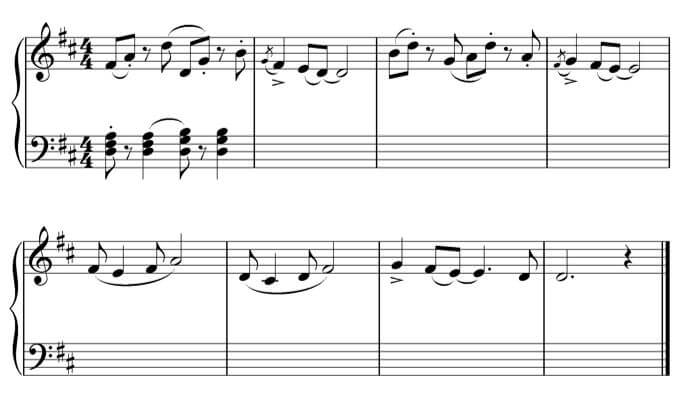
The harmonic material will be marked according to the following criteria:
| DESCRIPTION | MARK ALLOCATION | CANDIDATE'S MARKS |
| Chord progression Choice of chords, correct use of cadecence | 12 | |
| Correctness Notation, doubling, spacing, voice leading | 14 | |
| Quality Musicality, non-chordal notes, awareness of style, creativity | 4 | |
| 30/2 | ||
| TOTAL | 15 |
[15]
TOTAL SECTION A: 60
SECTIONS B, C, D, E: GENERAL MUSIC KNOWLEDGE (90 minutes)
- Answer SECTION B
- AND SECTION C (Western Art Music)
- OR SECTION D (Jazz)
- OR SECTION E (Indigenous African Music).
Answer ALL the questions in the ANSWER BOOK provided.
SECTION B: GENERAL (COMPULSORY)
QUESTION 5
5.1 Various options are provided as possible answers to the following questions. Choose the answer and write only the letter (A–D) next to the question number (5.1.1–5.1.10) in the ANSWER BOOK, for example 5.1.11 D.
5.1.1 How do you register and protect the copyright of your latest composition?
- Register the work at the magistrate's court.
- Post the work to a music publisher.
- Post the work to yourself.
- Ask your teacher to certify your work.
5.1.2 The following term is associated with the music industry:
- Needlework
- Needletime
- Needytime
- Needlepoint
5.1.3 The function of the recording company is to …
- advertise and distribute CDs.
- help artists to get a recording contract.
- record the artist's songs (album).
- All the above-mentioned
5.1.4 The function of a publishing company is to …
- prepare scores for publication.
- register the songs with an agency.
- collect the money and pay the songwriters their royalties.
- All the above-mentioned
5.1.5 Which ONE of the following is NOT involved in the music rights representation of the South African music industry?
- CAPASSO
- SAMRO
- EMI
- SAFACT
5.1.7 The term enharmonic describes notes with the same pitch which have …
- from the 4th to the 7th steps of a major scale.
- associated with dissonance in music.
- also called an augmented 4th interval.
- All the above-mentioned
5.1.6 The term tri-tone is …
- the same note value.
- the same key signature.
- different letternames.
- All the above-mentioned
5.1.8 Timbre is a particular …
- sound quality of an instrument or voice.
- form type in music.
- dynamic change in a piece, e.g. crescendo.
- change of time signature.
5.1.9 A whole-tone scale is a scale consisting of seven …
- semi-tones.
- minor 3rds.
- whole tones.
- None the above-mentioned
5.1.10 The term genre refers to a type of …
- scale.
- form.
- work.
- style. (10 x 1) (10)
5.2 Choose ONE description from COLUMN B that matches a term in COLUMN A. Write only the letter (A–R) next to the question number (5.2.1–5.2.10) in your ANSWERBOOK, for example 5.2.11 S.
| COLUMN A | COLUMN B |
5.2.1 Idiophone |
|
(10 x 1) (10)
TOTAL SECTION B: 20
Answer SECTION C (WAM)
OR SECTION D (JAZZ)
OR SECTION E (IAM).
SECTION C: WESTERN ART MUSIC (WAM)
QUESTION 6
6.1 Describe the form types of the following. Include references to key and key change.
6.1.1 Minuet and trio form (3)
6.1.2 Rondo form (3)
6.2 Define opera. (2)
6.3 What is the difference between Opera Buffa and Opera Seria? (2) [10]
QUESTION 7
Name ONE important aspect of EACH of the following elements with regard to Mendelssohn's Hebrides Overture: form, keys, harmony, dynamics and mood.[5]
QUESTION 8
Define the term aria and describe how the aria, Der Hölle Rache kocht in meinem herzen/The Hellish Fire Boils In My Heart, contributes towards the mood/atmosphere in Mozart's The Magic Flute. [5]
QUESTION 9
9.1 Identify the following motifs taken from works you have studied. Name the work and, where applicable, the movement from which EACH one comes.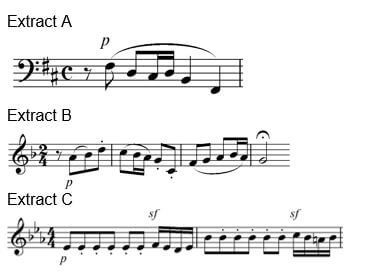 (3)
(3)
9.2 Name the stringed instruments that play the opening motifs in extracts A and B. (2) [5]
QUESTION 10
Write an essay in which you discuss Beethoven's creation of a programmatic symphony and how he achieved this goal through the use of instruments and tone painting in his Symphony No. 6.
The essay will be marked according to the following criteria:
| CRITERIA | MARK ALLOCATION |
| Programmatic content | 6 |
| Instrumentation/Tone Painting | 6 |
| Logical presentation and structure of the essay | 3 |
| TOTAL | 15 |
[15]
TOTAL SECTION C: 40
OR
SECTION D: JAZZ
QUESTION 11
11.1 Briefly describe the melody and rhythm of typical Cape jazz. (2)
11.2 Identify the features which make Spokes Mashiyane, Lemmy 'Special' Mabaso and Elias Lerole's music typical of the kwela style. (4)
11.3 Which South African jazz style do you associate with the following?
11.3.1 Ragtime
11.3.2 Organ sound
11.3.3 Mardi Gras
11.3.4 Avante-garde (4) [10]
QUESTION 12
Write a paragraph on the music contribution of ONE of the following South African female jazz artists:
- Dolly Rathebe
- Thandi Klaasen
- Miriam Makeba [5]
QUESTION 13
Describe the characteristics of the music of the band, The Brotherhood of Breath. [5]
QUESTION 14
Write a paragraph on the style characteristics that you would hear in a mbaqanga song. [5]
QUESTION 15
Write an essay in which you discuss the traditional and international influences on marabi as a South African jazz style. Include ONE artist and ONE song in your answer.
The essay will be marked according to the following criteria:
| CRITERIA | MARK ALLOCATION |
| Traditional influences | 6 |
| International influences | 4 |
| Artist and song | 2 |
| Logical presentation and structure of the essay | 3 |
| TOTAL | 15 |
[15]
TOTAL SECTION D: 40
OR
SECTION E: INDIGENOUS AFRICAN MUSIC (IAM)
QUESTION 16
16.1 Briefly define maskandi music in TWO sentences. (2)
16.2 Which stylistic features of free kiba makes it a traditional style of South African music? (4)
16.3 Which South African indigenous style do you associate with the following terms?
16.3.1 A cappella (1)
16.3.2 Ukupika (1)
16.4 Indicate whether the following statements are TRUE or FALSE. Write only the words 'true' or 'false' next to the question number, for example 16.4.3 True.
16.4.1 Praise poetry is always part of malombo music. (1)
16.4.2 Music is used in every aspect of life in indigenous African societies. (1) [10]
QUESTION 17
Describe the music characteristics of malombo music. [5]
QUESTION 18
Discuss the importance of dance (movement) in indigenous South African music. [5]
QUESTION 19
Write a paragraph on the style characteristics of mbaqanga songs. [5]
QUESTION 20
Isicathamiya reflects the cultural customs of the Zulu culture.
Write an essay in which you discuss the statement above. Link the cultural customs to the musical style characteristics.
The essay will be marked according to the following criteria:
| CRITERIA | MARK ALLOCATION |
| Cultural customs | 6 |
| Musical style characteristics | 6 |
| Logical presentation and structure of the essay | 3 |
| TOTAL | 15 |
[15]
TOTAL SECTION E: 40
GRAND TOTAL: 120
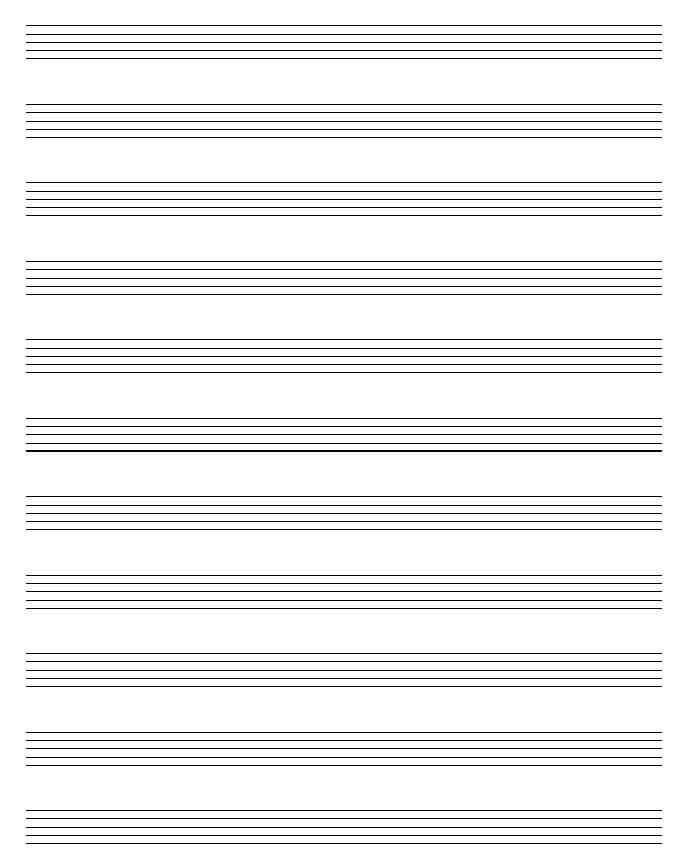
MUSIC PAPER 2 GRADE 12 QUESTIONS - NSC PAST PAPERS AND MEMOS FEBRUARY/MARCH 2018
MUSIC
PAPER 2
GRADE 12
NSC PAST PAPERS AND MEMOS
FEBRUARY/MARCH 2018
INSTRUCTIONS AND INFORMATION
- This question paper consists of THREE sections:
SECTION A: Aural (10)
SECTION B: Recognition (12)
SECTION C: Form (8) - QUESTION 1, QUESTION 2, QUESTION 3 and QUESTION 7 are COMPULSORY.
- Answer QUESTION 4 (Western Art Music (WAM)) OR QUESTION 5 (JAZZ) OR QUESTION 6 (Indigenous African Music (IAM)).
- Write ALL your answers on this question paper. Use a pencil for music notation and blue or black ink for the other answers.
- This examination will be done while candidates are listening to a CD.
- The music teacher of the centre must conduct the examination in the presence of the invigilator.
- The last page of this question paper is manuscript paper intended for rough work. The candidate MUST NOT remove this page.
- Candidates may NOT have access to any musical instrument for the duration of this examination.
- Candidates must take note of the mark allocation of each question in order to provide enough information in their answer.
- Write neatly and legibly.
INSTRUCTIONS TO THE PERSON OPERATING THE SOUND EQUIPMENT
- The instructions for the music teacher appear in frames.
- Each music extract (track) must be played the number of times specified in the question paper.
- Allow adequate time between tracks to give candidates time to think and write their answers before playing the next track.
- The number of the track must be announced clearly each time before it is played.
- If a school offers more than one stream (Western Art Music (WAM)), jazz, Indigenous African Music (IAM)), the following guidelines must be followed:
- Each stream must do the examination in a separate venue.
- Each venue must be equipped with suitable sound equipment.
- Each venue must have its own CD with music extracts.
- An invigilator must be present in each venue.
- The tracks have to be played as follows:
- WAM candidates: Tracks 1–24 and Track 37–39
- JAZZ candidates: Tracks 1–12, Tracks 25–30 and Track 37–39
- IAM candidates: Tracks 1–12 and Tracks 31–39
- A battery-powered CD player must be available in case of a power failure.
SUMMARY OF MARKS
SECTION A: AURAL | TOTAL |
QUESTION 1 (COMPULSORY) | 5 |
QUESTION 2 (COMPULSORY) | 5 |
SUBTOTAL | 10 |
SECTION B: RECOGNITION | TOTAL |
QUESTION 3 (COMPULSORY) | 4 |
QUESTION 4 (WAM) OR | 8 |
QUESTION 5 (JAZZ) OR | 8 |
QUESTION 6 (IAM) | 8 |
SUBTOTAL | 12 |
SECTION C: FORM | TOTAL |
QUESTION 7 (COMPULSORY) | 8 |
SUBTOTAL | 8 |
| GRAND TOTAL | 30 |
QUESTIONS
SECTION A: AURAL
QUESTION 1
Play Track 1 TWICE in succession. |
1.1 Listen to the melodic and rhythmic phrase. Notate the rhythm of the missing notes in bars 2–3 below. (2)
(2)
Play Track 1 TWICE again. Pause for 30 seconds in between. |
Play Track 2 THREE times in succession. |
1.2 Listen to the extract from the Chorale Ein' feste Burg by JS Bach. Which ONE of the melodies (a), (b) or (c) corresponds with the music that you hear? Make a cross (X) in the appropriate block. 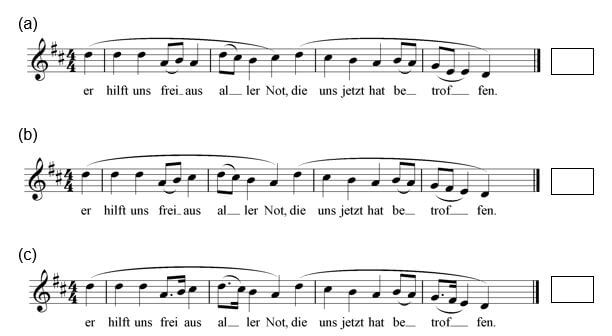 (1)
(1)
Play Track 3 ONCE. |
1.3 With which of the textures below do you associate this extract? Make a cross (X) in TWO appropriate blocks. (2)
Monophony | Polyphony | Homophony | Call and response |
[5]
QUESTION 2
Play Track 4 ONCE to provide a general overview. |
Listen to the extract from Minuetto Scherzando by A Scarlatti and answer the questions that follow.
Play Track 5 TWICE. |
2.1 Listen to bars 1–4. Name the interval formed between G and the missing note at 2.1, for example Major 3rd.
______________________________________ (1)
Play Track 6 TWICE. |
2.2 Listen to bars 5–8. Name the non-chordal note formed at 2.2, for example Passing note.
______________________________________ (1)
Play Track 7 THREE times. |
2.3 The notation of bar 3 was omitted from the score at 2.3. Fill in the missing pitches and note values that correspond with the melody that you hear. (3)
[5]
TOTAL SECTION A: 10
SECTION B: RECOGNITION OF MUSIC CONCEPTS
QUESTION 3: GENERAL LISTENING (COMPULSORY)
Study the items in COLUMN A in QUESTIONS 3.1–3.3 for two minutes.
Play Track 8 TWICE. |
3.1 Indicate TWO items in COLUMN A that relate to the music that you hear.
Make a cross (X) in TWO appropriate blocks. (2)
COLUMN A | Track 8 |
Female voices only |
|
Change of key |
|
A cappella |
|
Minor |
|
Repetition |
|
Instrumental |
|
Play Track 9 TWICE. |
3.2 Indicate TWO items in COLUMN A that relate to the music that you hear.
Make a cross (X) in TWO appropriate blocks. (2)
COLUMN A | Track 9 |
A cappella |
|
Change of key |
|
Marimba |
|
Trombone |
|
Saxophone |
|
Idiophones |
|
Play Track 10 TWICE. |
3.3 Indicate TWO items in COLUMN A that relate to the music that you hear.
Make a cross (X) in TWO appropriate blocks. (2)
COLUMN A | Track 10 |
Major |
|
Triple time |
|
Ostinato |
|
Quadruple time |
|
Adagio |
|
Minor |
|
3.4 Listen to the following TWO extracts and answer the questions that follow.
Play Track 11 ONCE. |
3.4.1 With which ONE of the following would you associate this extract?
Make a cross (X) in the appropriate block. (1)
March | Waltz | Tango | Hip-Hop |
Play Track 12 ONCE. |
3.4.2 With which ONE of the following would you associate this extract?
Make a cross (X) in the appropriate block. (1)
Glockenspiel | Bell | Harp | Harpsichord |
(8 ÷ 2) [4]
Answer QUESTION 4 (WAM) OR QUESTION 5 (JAZZ) OR QUESTION 6 (IAM).
QUESTION 4: WAM
4.1 Listen to the extracts from The Magic Flute by Mozart and answer the questions that follow.
Play Tracks 13, 14 and 15 ONCE each. |
4.1.1 Identify the most suitable term to describe the character of the extracts. Choose from the list below. Make a cross (X) in the appropriate block (3)
Term | Track 13 | Track 14 | Track 15 |
Lustig |
| ||
Semplice | |||
Subito | |||
Con fuoco | |||
Allegretto | |||
Grave |
Play Track 16 ONCE. |
4.1.2 Name the character that sings in this extract.
______________________________________ (1)
4.1.3 Name the voice type of this character.
______________________________________ (1)
4.2 Listen to the extracts and answer the questions that follow.
Play Track 17 ONCE. |
4.2.1 Identify the genre/work type of this extract, for example Concerto.
______________________________________(1)
4.2.2 Identify the composer of this extract.
_______________________________________(1)
4.2.3 What is the tonality of this extract?
______________________________________(1)
Play Track 18 ONCE. |
4.2.4 Identify the statement in COLUMN A that relates to the music that you hear. Make a cross (X) in the appropriate block. ate block. (1)
COLUMN A | Answer |
The double basses and cellos play a pedal point. | |
The double basses and cellos play tremolo. |
|
The violas and double basses play pizzicato. | |
The violas and cellos play an ostinato. |
Play Tracks 19, 20 and 21 ONCE each. |
4.2.5 Identify the woodwind instrument in EACH extract. Write the answer in the table below. (3)
TRACK | Name of instrument |
Track 19 | |
Track 20 | |
Track 21 |
Play Tracks 19, 20 and 21 ONCE more. |
4.3 Listen to the extracts and answer the questions that follow.
Play Track 22 ONCE. |
4.3.1 Name TWO compositional techniques used in this extract.
______________________________________________________________________________________________________ (2)
Play Tracks 23 and 24 TWICE in succession. |
4.3.2 Compare the melodies in the following two extracts and state ONE similarity and ONE difference.
Similarity: ___________________________________________________________________________
Difference: _________________________________________________________________________ (2) (16 ÷ 2) [8]
TOTAL SECTION B: 12
OR
QUESTION 5: JAZZ
5.1 Listen to the extract and answer the questions that follow.
Play Track 25 ONCE. |
5.1.1 Identify the South African jazz style that you hear in this extract.
______________________________________________________ (1)
5.1.2 Give TWO reasons, related to the music, to motivate your answer to QUESTION 5.1.1.
_______________________________________________________ (2)
5.2.3 Name ONE artist/band that you associate with this extract.
_______________________________________________________ (1)
5.2 Listen to the extracts and answer the questions that follow.
Play Track 26 ONCE. |
5.2.1 Identify the South African music style that you hear in this extract.
_______________________________________________________(1)
5.2.2 Name an artist that you associate with your answer to QUESTION 5.2.1.
_______________________________________________________ (1)
5.2.3 Name the compositional technique used in the piano part.
_______________________________________________________ (1)
5.2.4 Identify ONE idiophone that you hear in this extract.
_______________________________________________________(1)
Play Track 27 ONCE. |
5.2.5 Describe the use of rhythm that you hear in the piano part.
______________________________________________________________________________________________________________(2)
5.3 Listen to the extract and answer the questions that follow.
Play Track 28 TWICE. |
5.3.1 Name an artist that you associate with this extract.
_____________________________________________________(1)
5.3.2 Describe the music style you hear in this extract by referring to THREE musical features.
______________________________________________________________________________________________________________ (3)
Play Track 29 and Track 30 TWICE in succession. |
5.4 Listen to the two extracts and identify TWO differences with regards to the beat and instruments that drive the rhythm. (4)
Feature | Track 29 | Track 30 |
Beat |
| |
Instruments |
(16 ÷ 2) [8]
TOTAL SECTION B: 12
OR
QUESTION 6: IAM
6.1 Listen to the extracts and answer the questions that follow.
Play Track 31 ONCE. |
6.1.1 Identify the South African style of music heard in this extract
_______________________________________(1)
6.1.2 Give THREE reasons, related to the music, to motivate your answer to QUESTION 6.1.1.
______________________________________________________ (3)
Play Track 32 ONCE. |
6.1.3 Give TWO features that make this extract different from the original style mentioned in QUESTION 6.1.1.
______________________________________________________ (2)
6.1.4 Name an artist associated with this extract.
______________________________________________________ (1)
6.2 Listen to the extract and answer the question that follows.
Play Track 33 ONCE. |
6.2.1 Describe the use of rhythm between the clapping and the drums.
___________________________________________________________________ (2)
6.2.2 Identify the idiophone that you hear.
______________________________________________________ (1)
6.3 Identify TWO differences in the extracts that you hear with regard to the relevant style and the use of drums. (4)
Play Tracks 34 and 35 TWICE in succession. |
Criteria | Track 34 | Track 35 |
Style |
| |
Drums |
6.4 Listen to the extract and answer the questions that follow.
Play Track 36 ONCE. |
6.4.1 Identify the South African music style that you hear in this extract.
____________________________________________(1)
6.4.2 Name an artist/band that you associate with this extract.
____________________________________________ (1)
(16 ÷ 2) [8]
TOTAL SECTION B: 12
SECTION C: FORM
QUESTION 7
Read and study the questions for ONE minute.
Play Track 37 ONCE to provide an overview. |
Listen to the extract from Minuet in G by Beethoven while you study the score.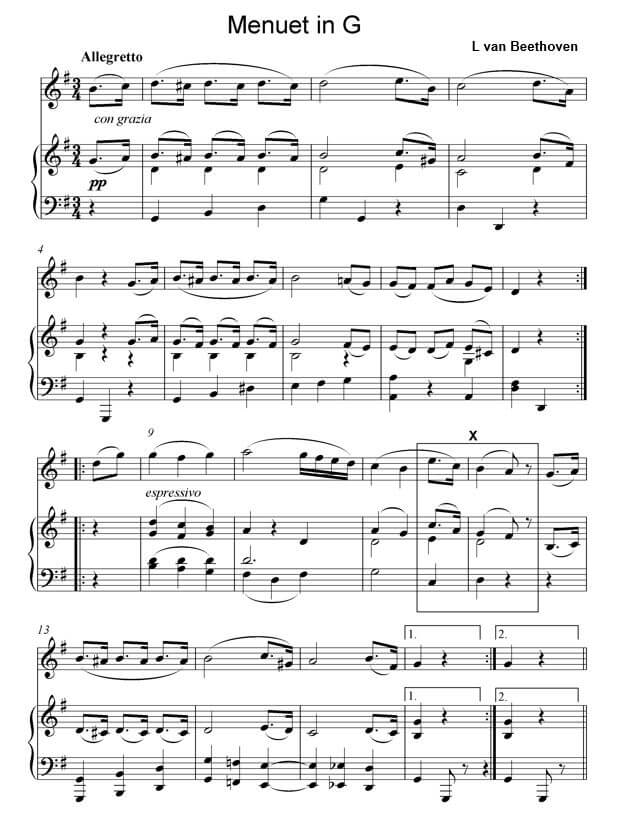
Play Track 37 again. |
7.1 Name the main key of this work.
____________________________________________(1)
7.2 What is the form of this piece?
___________________________________________ (1)
7.3 Motivate your answer to QUESTION 7.2 by giving a schematic layout of the form of this piece. Use the table below.(2)
SeCTION | Bar numbers |
7.4 To which key does the piece modulate in bars 7–8?
________________________________________________ (1)
7.5 What is the function of the A# note in bar 5?
________________________________________________ (1)
Play Track 38 again. |
7.6 Name the cadence formed at X.
________________________________________________ (1)
7.7 Give the meaning of allegretto.
________________________________________________ (1)
Play Track 39 for a general overview. |
TOTAL SECTION C: 8
GRAND TOTAL: 30
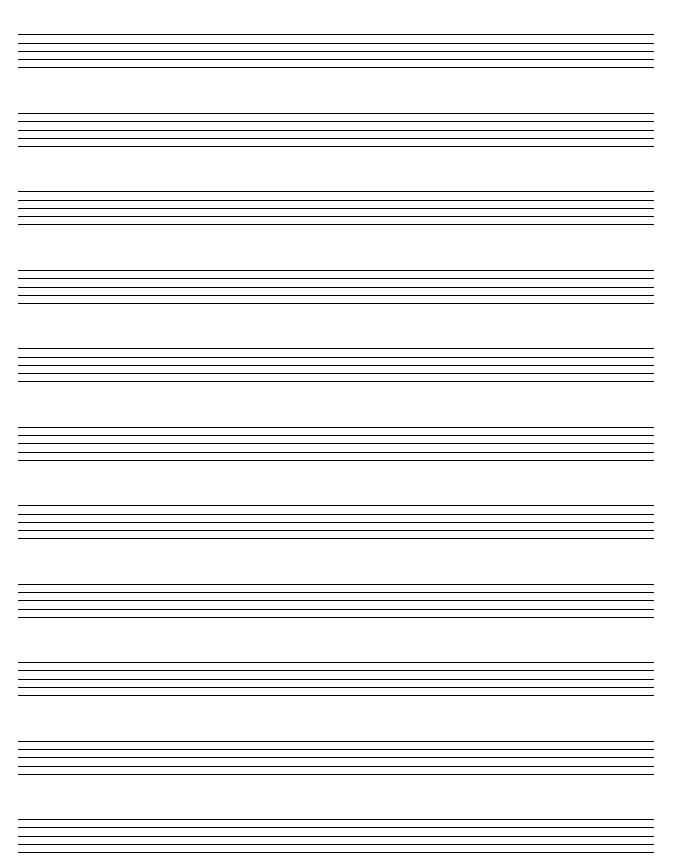
MUSIC PAPER 2 GRADE 12 MEMORANDUM - NSC PAST PAPERS AND MEMOS FEBRUARY/MARCH 2018
MUSIC
PAPER 2
GRADE 12
NSC PAST PAPERS AND MEMOS
FEBRUARY/MARCH 2018
INSTRUCTIONS AND INFORMATION
- This question paper consists of THREE sections:
SECTION A: Aural (10)
SECTION B: Recognition (12)
SECTION C: Form (8) - QUESTION 1, QUESTION 2, QUESTION 3 and QUESTION 7 are COMPULSORY.
- Answer QUESTION 4 (Western Art Music (WAM)) OR QUESTION 5 (JAZZ) OR QUESTION 6 (Indigenous African Music (IAM)).
- Write all your answers on this question paper. Use a pencil for music notation and blue or black ink for the other answers.
- This examination will be done while candidates are listening to a CD.
- The music teacher of the centre must conduct the examination in the presence of the invigilator.
- The last page of this question paper is manuscript paper intended for rough work. The candidate MUST NOT remove this page.
- Candidates may NOT have access to any musical instrument for the duration of this examination.
- Candidates must take note of the mark allocation of each question in order to provide enough information in their answer.
- Write neatly and legibly.
INSTRUCTIONS TO THE PERSON OPERATING THE SOUND EQUIPMENT
- The instructions for the music teacher appear in frames.
- Each music extract (track) must be played the number of times specified in the question paper.
- Allow adequate time between tracks to give candidates time to think and write their answers before playing the next track.
- The number of the track must be announced clearly each time before it is played.
- If a school offers more than one stream (Western Art Music (WAM)), jazz, Indigenous African Music (IAM)), the following guidelines must be followed:
- Each stream must do the examination in a separate venue.
- Each venue must be equipped with suitable sound equipment.
- Each venue must have its own CD with music extracts.
- An invigilator must be present in each venue.
- The tracks have to be played as follows:
- WAM candidates: Tracks 1–24 and Track 37–39
- JAZZ candidates: Tracks 1–12, Tracks 25–30 and Track 37–39
- IAM candidates: Tracks 1–12 and Tracks 31–39
- A battery-powered CD player must be available in case of a power failure.
SUMMARY OF MARKS
SECTION A: AURAL | TOTAL |
QUESTION 1 (COMPULSORY) | 5 |
QUESTION 2 (COMPULSORY) | 5 |
SUBTOTAL | 10 |
SECTION B: RECOGNITION | TOTAL |
QUESTION 3 (COMPULSORY) | 4 |
QUESTION 4 (WAM) OR | 8 |
QUESTION 5 (JAZZ) OR | 8 |
QUESTION 6 (IAM) | 8 |
SUBTOTAL | 12 |
SECTION C: FORM | TOTAL |
QUESTION 7 (COMPULSORY) | 8 |
SUBTOTAL | 8 |
| GRAND TOTAL | 30 |
MEMORANDUM
Note to marker: Candidates must be credited for any correct answers not given in the memorandum.
SECTION A: AURAL
QUESTION 1
Play Track 1 TWICE in succession. |
1.1 Listen to the melodic and rhythmic phrase. Notate the rhythm of the missing notes in bars 2–3 below.
Play Track 1 TWICE again. Pause for 30 seconds in between. |
Answer:  (2)
(2)
| 1 mark per bar = 2 marks Minus ½ mark per mistake up to a maximum of 1 mark per bar |
Play Track 2 THREE times in succession. |
1.2 Listen to the extract from the Chorale Ein' feste Burg by JS Bach. Which ONE of the melodies (a), (b) or (c) corresponds with the music that you hear? Make a cross (X) in the appropriate block.
Correct answer = 1 mark (1)
Play Track 3 ONCE. |
1.3 With which of the textures below do you associate this extract? Make a cross (X) in TWO appropriate blocks.
Answer: | Monophony AND Homophony TWO correct answers = 2 marks | (2) |
[5]
QUESTION 2
Play Track 4 ONCE to provide a general overview. |
Listen to the extract from Minuetto Scherzando by A Scarlatti and answer the questions that follow.
Answer:
Play Track 5 TWICE. |
2.1 Listen to bars 1–4. Name the interval formed between G and the missing note at 2.1, for example Major 3rd.
Answer: (Perfect) Octave = 1 mark (1)
Play Track 6 TWICE. |
2.2 Listen to bars 5–8. Name the non-chordal note formed at 2.2, for example Passing note.
Answer: (Lower) Auxiliary note = 1 mark (1)
Play Track 7 THREE times. |
2.3 The notation of bar 3 has been omitted on the score at 2.3. Fill in the missing pitches and note values that correspond with the music that you hear.
Answer: See score: Correct pitch and note value = 1 mark each = 3 marks
No mark for correct pitch or note value only (3)
[5]
TOTAL SECTION A: 10
SECTION B: RECOGNITION OF MUSIC CONCEPTS
QUESTION 3: GENERAL LISTENING (COMPULSORY)
Study the items in COLUMN A in QUESTIONS 3.1–3.3 for two minutes.
Note to marker: If a candidate selected more than two items at a question, only the first two items must be marked.
Play Track 8 TWICE. |
3.1 Indicate TWO items in COLUMN A that relate to the music that you hear.
Make a cross (X) in TWO appropriate blocks.
Answer:
COLUMN A | Track 8 |
Female voices only |
|
Change of key | X |
A Cappella | X |
Minor |
|
Repetition | X |
Instrumental |
|
Any TWO correct answers = 2 marks (2)
Play Track 9 TWICE. |
3.2 Indicate TWO items in COLUMN A that relate to the music that you hear.
Make a cross (X) in TWO appropriate blocks.
Answer:
COLUMN A | Track 9 |
A Cappella |
|
Change of key |
|
Marimba | X |
Trombone |
|
Saxophone | X |
Idiophones | X |
Any TWO correct answers = 2 marks (2)
Play Track 10 TWICE. |
3.3 Indicate TWO items in COLUMN A that relate to the music that you hear.
Make a cross (X) in TWO appropriate blocks.
Answer:
COLUMN A | Track 10 |
Major | X |
Triple time |
|
Ostinato | X |
Quadruple time | X |
Adagio |
|
Minor |
|
Any TWO correct answers = 2 marks (2)
3.4 Listen to the following TWO extracts and answer the questions that follow.
Play Tracks 11 ONCE. |
3.4.1 With which ONE of the following do you associate this extract?
Make a cross (X) in the appropriate block.
Answer: Waltz = 1 mark (1)
Play Tracks 12 ONCE. |
3.4.2 With which ONE of the following do you associate this extract?
Make a cross (X) in the appropriate block.
Answer: Harp = 1 mark (1)
(8 ÷ 2) [4]
Answer QUESTION 4 (WAM) OR QUESTION 5 (JAZZ) OR QUESTION 6 (IAM).
QUESTION 4: WAM
4.1 Listen to the extracts from The Magic Flute by Mozart and answer the questions that follow.
Play Track 13, Track 14 and Track 15 ONCE each. |
4.1.1 Identify the most suitable term to describe the character of the extracts. Choose from the list below. Make a cross (X) in the appropriate block.
Answer:
Term | Track 13 | Track 14 | Track 15 |
Lustig | X | ||
Semplice | |||
Subito | |||
Con fuoco | X | ||
Allegretto | |||
Grave | X |
One mark per extract x 3 = 3 marks (3)
Play Track 16 ONCE. |
4.1.2 Name the character that sings in this extract.
Answer: Tamino = 1 mark(1)
4.1.3 Name the voice type of this character.
Answer: Tenor = 1 mark (1)
4.2 Listen to the extracts and answer the questions that follow.
Play Track 17 ONCE. |
4.2.1 Identify the genre/work type of this extract, for example Concerto.
Answer: Symphony = 1 mark (1)
4.2.2 Identify the composer of this extract.
Answer: Beethoven = 1 mark (1)
4.2.3 What is the tonality of this extract?
Answer: Minor = 1 mark (1)
Play Track 18 ONCE. |
4.2.4 Identify the statement in COLUMN A that relates to the music that you hear. Make a cross (X) in the appropriate block.
Answer: (1)
COLUMN A |
| ||
The double basses and cellos play a pedal point | |||
The double basses and cellos play tremolo | X | ||
The violas and double basses play pizzicato | |||
The violas and cellos play an ostinato | |||
Correct answer = 1 mark | |||
Play Track 19, Track 20 and Track 21 ONCE each. |
4.2.5 Identify the woodwind instrument in EACH extract. Write the answer in the table below.
Answer:
Track 19 | Flute |
Track 20 | Oboe |
Track 21 | Clarinet |
One mark per correct instrument x 3 = 3 marks (3)
Play Track 19, Track 20 and Track 21 ONCE more. |
4.3 Listen to the extracts and answer the questions that follow.
Play Track 22 ONCE. |
4.3.1 Name TWO compositional techniques used in this extract? (2)
Answer: |
Any TWO correct answers = 2 marks |
Play Track 23 and 24 TWICE in succession. |
4.3.2 Compare the melodies in the following two extracts and state ONE similarity and ONE difference.
Answer:
Similarities |
|
Differences |
|
Any ONE correct similarity and difference = 2 marks (2)
(16 ÷ 2) [8]
TOTAL SECTION B: 12
OR
QUESTION 5: JAZZ
5.1 Listen to the extract and answer the questions that follow.
Play Track 25 ONCE. |
5.1.1 Identify the South African jazz style that you hear in this extract.
Answer: Marabi = 1 mark (1)
5.1.2 Give TWO reasons, related to the music, to motivate your answer to QUESTION 5.1.1.
Answer: |
Any TWO correct answers = 2 marks (2) |
5.2.3 Name ONE artist/band that you associate with this extract.
Answer: |
Any 1 correct answer = 1 mark (1) |
5.2 Listen to the extracts and answer the questions that follow.
Play Track 26 ONCE. |
5.2.1 Identify the South African jazz style that you hear in this extract.
Answer: |
Any correct answer = 1 mark (1) |
5.2.2 Name an artist that you associate with your answer to QUESTION 5.2.1.
Answer: Winston Mankunku = 1 mark (1)
5.2.3 Name the compositional technique used in the piano part.
Answer: Ostinato/Riff = 1 mark (1)
5.2.4 Name ONE idiophone that you hear in this extract.
Answer: Cymbals/Hi-hat = 1 mark (1)
Play Track 27 ONCE. |
5.2.5 Describe the use of rhythm that you hear in the piano part.
Answer: |
TWO correct answers = 2 marks (2) |
5.3 Listen to the extract and answer the questions that follow.
Play Track 28 TWICE. |
5.3.1 Name an artist that you associate with this extract.
Answer: |
Any ONE correct answer = 1 mark (1) |
5.3.2 Describe the music style you hear in this extract by referring to THREE musical features.
Answer: |
Any THREE correct answers = 3 marks (3) |
Play Track 29 and Track 30 TWICE in succession |
5.4 Listen to the following TWO extracts and identify TWO differences with regards to the beat and instruments that drive the rhythm.
Answer:
Feature | Track 29 | Track 30 |
Beat | Ghoema beat | Skiffle-like beat |
Instruments | Piano/drums/bass | Penny whistle/ Guitar/banjo/drums |
Any two corresponding correct answers x2 = 4 marks (4)
(16 ÷ 2) [8]
TOTAL SECTION B: 12
OR
QUESTION 6: IAM
6.1 Listen to the extracts and answer the questions that follow.
Play Track 31 ONCE. |
6.1.1 Identify the South African style of music heard in this extract.
Answer: Isicathamiya = 1 mark (1)
6.1.2 Give THREE reasons, related to the music, to motivate your answer to QUESTION 6.1.1.
Answer: |
Any THREE correct answers = 3 marks (3) |
Play Track 32 ONCE. |
6.1.3 Give TWO features that make this extract different from the original style mentioned in QUESTION 6.1.1.
Answer: |
Any TWO correct answers = 2 marks (2) |
6.1.4 Name an artist associated with this extract.
Answer: Ladysmith Black Mambazo = 1 mark (1)
6.2 Listen to the extract and answer the questions that follow.
Play Track 33 ONCE. |
6.2.1 Describe the use of rhythm between the clapping and the drums.
Answer: |
Any TWO correct answers = 2 marks (2) |
6.2.2 Identify the idiophone that you hear.
Answer: Cow bell = 1 mark (1)
Play Tracks 34 and 35 TWICE in succession. |
6.3 Identify TWO differences in the extracts that you hear with regard to the relevant style and the use of drums.
Answer:
Criteria | Track 34 | Track 35 |
Style | Maskandi
| Traditional Basotho style (Famo) |
Drums | Drumkit: To keep the beat and to give a contemporary sound | Traditional, home-made drums: To keep the beat and create polyrhythm |
Any TWO corresponding correct answers x 2 = 4 marks (4)
6.4 Listen to the extract and answer the questions that follow.
Play Track 36 ONCE. |
6.4.1 Identify the South African music style that you hear in this extract.
Answer: Malombo = 1 mark (1)
6.4.2 Name an artist/band that you associate with this extract.
Answer: |
Any correct answer = 1 mark (1) |
(16 ÷ 2) [8]
TOTAL SECTION B: 12
SECTION C: FORM
QUESTION 7
Read and study the questions for ONE minute.
Play Track 37 ONCE to provide an overview. |
Listen to the extract from Minuet in G by Beethoven while you study the score.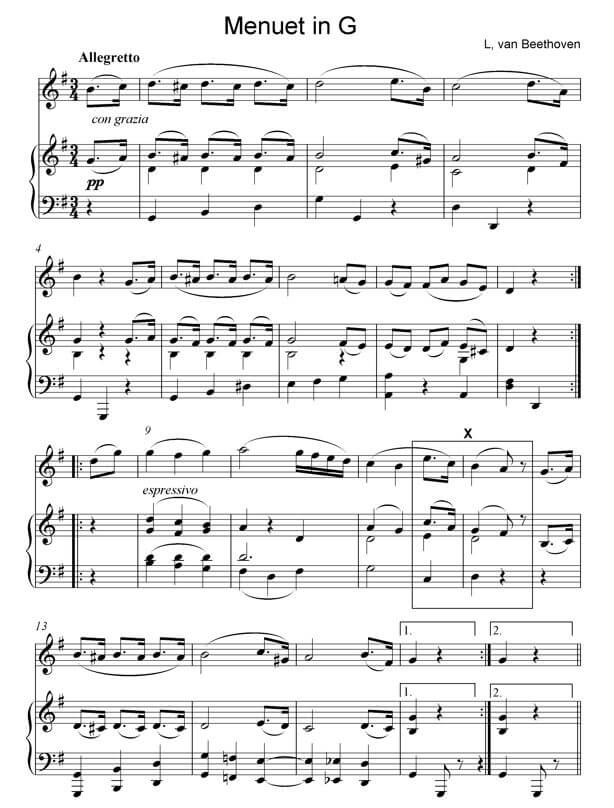
Play Track 37 again. |
7.1 Name the main key of this work.
Answer: G Major = 1 mark (1)
7.2 What is the form of this piece?
Answer: |
Any correct answer = 1 mark (1) |
7.3 Motivate your answer to QUESTION 7.2 by giving a schematic layout of the form of this piece. Use the table below.
Answer:
Rounded Binary
Section | Bar numbers | ||
A | = ½ | 03–82 | = ½ |
B | = ½ | 83–122 | = ½ |
½ mark for Section A |
= 1 mark |
½ mark for correct bar numbers in Section A | |
½ mark for correct divisions in Section Ba |
= 1 mark |
½ mark for correct bar numbers in Section Ba |
Binary (2)
Section | Bar numbers |
A = ½ | 03–82 = ½ |
B = ½ | 83–162 = ½ |
½ mark for each correct section | = 1 mark |
½ mark for each correct bar number | = 1 mark |
Note to marker: |
If the bar numbers and the section letters do not correspond ½ mark will be awarded for the section and no mark will be awarded for the bar numbers. |
7.4 To which key does the piece modulate in bars 7–8?
Answer: D major = 1 mark (1)
7.5 What is the function of the A# note in bar 5?
Answer: |
Any correct answer = 1 mark (1) |
Play Track 38 again. |
7.6 Name the cadence formed at X.
Answer: Imperfect cadence = 1 mark (1)
7.7 Give the meaning of allegretto.
Answer: Fairly lively and jolly = 1 mark (1)
Play Track 39 for an overview. |
[8]
TOTAL SECTION C: 8
GRAND TOTAL: 30
MUSIC PAPER 1 GRADE 12 MEMORANDUM - NSC PAST PAPERS AND MEMOS FEBRUARY/MARCH 2018
MUSIC
PAPER 1
GRADE 12
NSC PAST PAPERS AND MEMOS
FEBRUARY/MARCH 2018
INSTRUCTIONS AND INFORMATION
- This question paper consists of FIVE sections, namely SECTIONS A, B, C, D and E.
- SECTIONS A and B are compulsory.
- SECTION C: WESTERN ART MUSIC (WAM), SECTION D: JAZZ and SECTION E: INDIGENOUS AFRICAN MUSIC (IAM) are choice questions. Answer only ONE of these sections (SECTION C or D or E).
- Write all music notation in SECTION A in pencil and all written text in blue or black ink on this question paper.
- Answer SECTION B and SECTION C or D or E in blue or black ink in the ANSWER BOOK provided.
- Number the answers correctly according to the numbering system used in this question paper.
- The last page of this question paper is manuscript paper intended for rough work. Candidates may remove this page.
- Candidates may NOT have access to any musical instrument for the duration of this examination.
- Candidates must take note of the mark allocation of each question in order to provide enough information in their answer.
- Write neatly and legibly.
MARKING GRID
SECTION | QUESTION | MARKS | MARKER | MODERATOR |
A: THEORY OF MUSIC (COMPULSORY) | 1 | 20 | ||
2 | 15 | |||
3 | 10 | |||
4 | 15 | |||
SUBTOTAL | 60 |
|
| |
AND | ||||
B: GENERAL (COMPULSORY) | 5 | 20 | ||
SUBTOTAL | 20 |
|
| |
AND | ||||
C: WAM | 6 | 10 | ||
7 | 5 | |||
8 | 5 | |||
9 | 5 | |||
10 | 15 | |||
SUBTOTAL | 40 |
|
| |
OR | ||||
D: JAZZ | 11 | 10 | ||
12 | 5 | |||
13 | 5 | |||
14 | 5 | |||
15 | 15 | |||
SUBTOTAL | 40 |
|
| |
OR | ||||
E: IAM | 16 | 10 | ||
17 | 5 | |||
18 | 5 | |||
19 | 5 | |||
20 | 15 | |||
SUBTOTAL | 40 |
|
| |
| ||||
GRAND TOTAL | 120 |
|
| |
MEMORANDUM
SECTION A: THEORY OF MUSIC (COMPULSORY) (90 minutes)
Answer QUESTION 1
AND QUESTION 2.1 OR 2.2
AND QUESTION 3.1 OR 3.2
AND QUESTION 4.1 OR 4.2.
Answer the questions in the spaces provided on this question paper.
QUESTION 1 (25 minutes)
Study the extract from Send in the Clowns by Stephen Sondheim below and answer the questions that follow.
1.1 Name the key of the work.
Answer:
- Eb major = 1 mark (1)
1.2 What is the relative minor of the main key?
Answer:
- C minor = 1 mark (1)
1.3 Transpose the first four notes of the violin part a major third higher on the given stave below. Use a new key signature.
Answer  (2)
(2)
| Key signature = 1 mark Notation = 1 mark (Minus ½ mark per mistake to a maximum of 1 mark) (No penalisation if time signature is left out) |
1.4 Name the intervals at 1.4.1 and 1.4.2 according to type and distance.
Answer:
1.4.1 Minor 7th
1.4.2 Major 10th/Compound Major 3rd (2)
| 1 mark each 1.4.2 Major 3rd only = ½ mark No mark for distance only |
1.5 Name the triads at A and B according to type and position, for example Major, second inversion. (Consider only the notes in the block.)
Answer:
A: Minor second inversion
B: Minor first inversion (2)
| Type= ½ mark each Position = ½ mark each (4 x ½) = 2 |
1.6 Rewrite the violin part at X using half the note values. Insert the new time signature.
Answer: (2)
(2)
| Time signature= 1 mark Notation= 1 mark (Minus ½ mark per error up to 1 mark) |
1.7 Rewrite the violin part at Y in the corresponding simple quadruple time, using the alto clef.
Answer: (3)
(3)
| Clef = 1 mark Time signature = 1 mark Notation = 1 mark (Minus ½ mark per error up to 1 mark) |
1.8 Give the meaning of the Italian term, Adagio.
Answer:
(1)
| Slow (tempo) = 1 mark |
1.9 In which scale/mode is the following melody written?
Answer: (1)
(1)
| Blues scale (on E) = 1 mark |
1.10 Write the melodic form of the B minor scale, descending, using the alto clef. Write without a key signature, use semibreves and mark the semitones.
Answer:
 (3)
(3)
| Clef = 1 mark Semitones = ½ mark each = 1 mark Notation = 1 mark (Minus ½ mark per error up to a maximum of 1 mark) |
1.11 Complete the fragment by writing sequences of motif (a) in bars 2 and 3.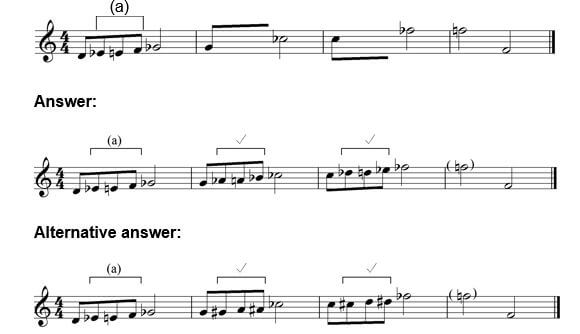
| 1 mark per sequence = 2 marks (Minus ½ mark per mistake up to a maximum of 2 marks) Any correct chromatic spelling must be accepted |
(2)
[20]
QUESTION 2 (25 minutes)
Answer EITHER QUESTION 2.1 OR QUESTION 2.2.
2.1 Complete the opening motif below to form a twelve-bar melody in ternary form for any single-line melodic instrument of your choice. Name the instrument for which you are writing. Indicate the tempo and add dynamic and articulation marks.
Concept answer:
Instruments: Bassoon, Trombone, Cello, Bass guitar, Double bass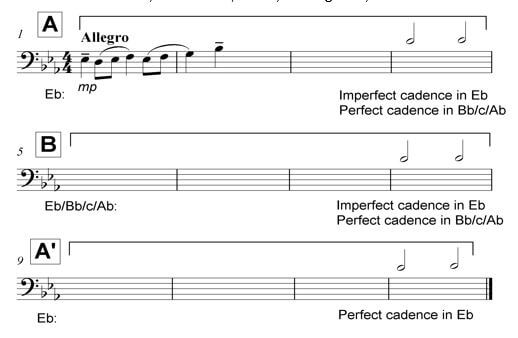
OR
2.2 Concept answer:
Instrument: Flute, Oboe, Clarinet, Trumpet, Violin, Guitar, Saxophone, Marimba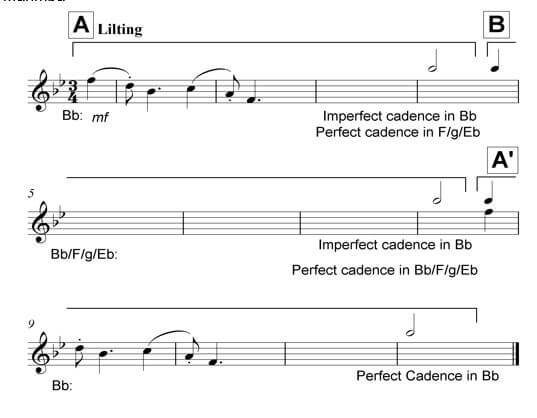
The melody will be marked according to the following criteria:
DESCRIPTION | MARK ALLOCATION | ||
Form and cadential points | 1 mark per phrase x 3 | 3 | |
Correctness | Minus ½ mark per error up to 2 marks | 2 | |
Quality
| 9–10 | Excellent Coherent and musical; phrases imaginatively define the form; opening motif innovatively continued; successful use of tonality; melodic shape masterfully handled; creative approach to choice of pitches and rhythm | 10 |
7–8 | Good Correct and musical; phrases clearly indicate the form; opening motif sensibly continued; stable tonality; melodic shape satisfying; choice of pitches and rhythm accurate | ||
4–6 | Average Musically not convincing; not all phrases clear; opening motif not well utilised; tonality unstable; melodic shape is suspect; choice of pitches and rhythm unimaginative | ||
0–3 | Not acceptable No musical sense; no sense of phrasing; opening motif ignored; no sense of tonal centre; no melodic shape; pitches and rhythm random | ||
TOTAL | Markers may use ½ marks | 15 | |
QUESTION 3 (10 minutes)
Answer EITHER QUESTION 3.1 OR QUESTION 3.2.
3.1 Study the extract below and answer the questions that follow.
Answer: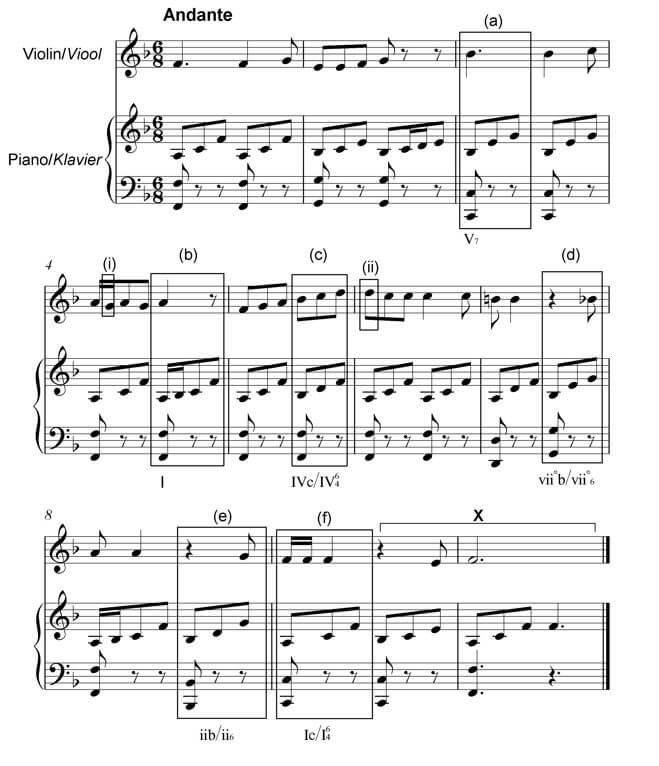
3.1.1 Identify the chords from (a)–(f) and figure them on the score, e.g. iiib/iii6
Answer:
See score: (6)
| 1 mark per chord = 6 marks (Minus ½ mark for each error) (Key indication not compulsory) V only = ½ mark |
3.1.2 Name the type of non-chordal notes at (i) and (ii)
Answer: (2)
| (i) (Lower) Auxiliary note = 1 mark (ii) Suspension = 1 mark |
3.1.3 Identify the cadence at X. Write down the chord progression and the name of the cadence.
Answer:
V7 – I
Perfect (Cadence) (2)
| V7 – I = 1 mark V only = ½ mark Perfect (Cadence) = 1 mark |
[10]
OR
3.2 Study the extract below and answer the questions that follow.
Answer: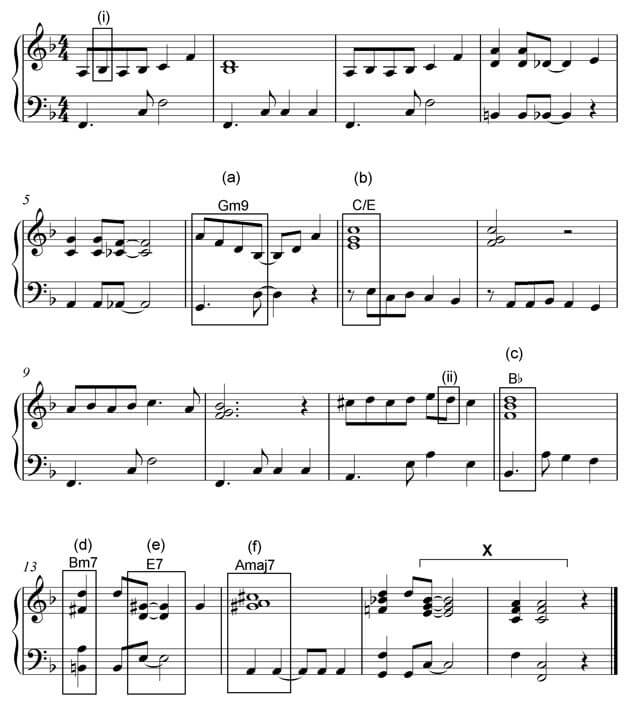
3.2.1 Identify the chords from (a)–(f) and figure them on the score, e.g. B/F# (6)
| 1 mark per chord = 6 marks (Key indication not compulsory) If chord symbols are partially correct (e.g. 7th is missing) = ½ mark |
3.2.2 Name the type of non-chordal notes at (i) and (ii)
Answer: (2)
| (i) (Upper) Auxiliary note = 1 mark (ii) Passing note = 1 mark |
3.2.3 Identify the cadence at X. Write down the chord symbols and the name of the cadence.
Answer: (2)
| C7 (½ mark) – F (½mark) = 1 mark Perfect (Cadence) = 1 mark |
[10]
QUESTION 4 (30 minutes)
Answer EITHER QUESTION 4.1 OR QUESTION 4.2.
4.1 Complete the four-part vocal harmonisation below by adding the alto, tenor and bass parts.
Concept answer: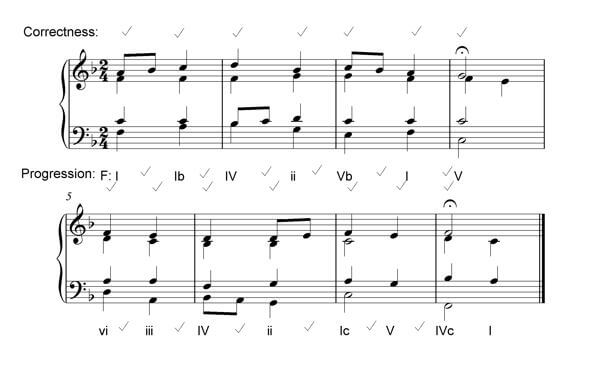
The answer will be marked according to the following criteria:
DESCRIPTION | MARK ALLOCATION | ||
Chord progression | 1 mark between each pair of chords (except between bars 4 and 5) | 12 | |
Correctness | Minus ½ mark per error but not more than 1 mark per chord | 14 | |
Quality |
| = 3½–4 marks | 4 |
| Note to marker:
| 30÷2 = 15 | |
TOTAL |
| 15 | |
OR
4.2 Complete the piece below by adding suitable harmonic material in the open stave. Continue in the style suggested by the given material in bar 1.
Concept answer:
The answer will be marked according to the following criteria:
DESCRIPTION | MARK ALLOCATION | ||
Chord progression | 1 mark between each pair of chords (except between bars 4 and 5) | 12 | |
Correctness | Minus ½ mark per error but not more than 2 marks per bar | 14 | |
Quality |
| = 3½–4 marks | 4 |
| Note to marker: Mark out of 30 must not contain a ½ mark | 30÷2 = 15 | |
TOTAL |
| 15 | |
TOTAL SECTION A: 60
SECTIONS B, C, D, E: GENERAL MUSIC KNOWLEDGE (90 minutes)
Answer SECTION B
AND SECTION C (Western Art Music)
OR SECTION D (Jazz)
OR SECTION E (Indigenous African Music).
Answer these questions in the ANSWER BOOK provided.
SECTION B: GENERAL (COMPULSORY)
QUESTION 5
5.1
5.1.1 C
5.1.2 B
5.1.3 D
5.1.4 D
5.1.5 C
5.1.6 D
5.1.7 C
5.1.8 A
5.1.9 D
5.1.10 C (10)
5.2
| A | B |
5.2.1 | Idiophone | M |
5.2.2 | Ostinato | C |
5.2.3 | Chordophone | A |
5.2.4 | D.C. | N |
5.2.5 | Call and response | L |
5.2.6 | A cappella | K |
5.2.7 | Improvisation | H |
5.2.8 | Ternary form | D |
5.2.9 | Very fast | Q |
5.2.10 | Falsetto | B |
(10) TEN correct answers = 10 marks
[10]
TOTAL SECTION B: 20
Answer SECTION C (WAM)
OR SECTION D (JAZZ)
OR SECTION E (IAM).
SECTION C: WESTERN ART MUSIC (WAM)
QUESTION 6
6.1
6.1.1
- Three large subdivisions: Minuet (A), Trio (B), Minuet (A); Each section (A – aaba; B – ccdc; A aaba); usually in rounded binary form (compound ternary form)
- The Trio (B) is usually different in character and key from Minuet
- A – Tonic, B – Tonic or Related key; A – Tonic (3)
TWO correct facts relating to form = 2 marks
One correct fact relating to key = 1 mark
6.1.2
- ABACA (or ABACADA Old Rondeau)
- The main section or theme, A, returns after each contrasting (B/C) section (episodes)
- A – Tonic, B – Related key (dominant), A – Tonic, C – Related key (relative minor), A - Tonic (3)
TWO correct facts relating to form = 2 marks
One correct fact relating to key = 1 mark
(3 x 2) (6)
6.2
- Dramatic work for voices and orchestral accompaniment
- Combines music, drama, costumes, décor and often dance (2)
1 mark for 'voices and orchestra'
1 mark for idea of 'combination'
6.3 Opera buffa
- Opera with comic subject matter
- Stories often light-hearted and romantic
- The comic characters are from the working class e.g. maids, peasants, servants
Opera seria
- Opera with serious subject matter
- Stories often tragic or heroic
- Typically involves royalty or ancient myths and gods (2)
Correct fact for Opera Buffa = 1 mark
Correct fact for Opera Seria = 1 mark
[10]
QUESTION 7
Form
- Sonata form
- Exposition, Development, Recapitulation, Coda
- Uses a new genre: concert overture
Keys
- Begins in B minor
- Second subject in D major (modulates to relative major)
Harmony
- Uses classical, tonal harmony
Dynamics
- Wide dynamic range: pp to ff
- Expressive use of dynamics to depict nature through sound
Mood
- Brooding mood initially depicting the seascape
- Mood changes according to the suggested program
ONE correct answer from each element = 5 marks [5]
QUESTION 8
Aria: Definition
- An aria written for solo vocalist with instrumental accompaniment
- A song used for stating a particular emotion(s) of a character
TWO correct facts = 2 marks
Mood: Der Hölle Rache
- Depicts a fit of vengeful rage and anger - minor key, fast tempo, ff-dynamics
- Dark impressive mood and dramatic drive – fast tempo, extreme melodic range
- Dramatic flair, theatrical emphasis and spectacle of voice – short melodic phrases, coloratura soprano
THREE correct facts = 3 marks
[5]
QUESTION 9
9.1
A: Hebrides or Fingal's Cave
B: Pastorale Symphony no 6, 1st movement
C: Overture to The Magic Flute (3)
| Correct answers = 3 marks (Answers must be complete – no ½ marks) |
9.2
A: Violas/cellos
B: Violins (2)
| Correct answers = 2 marks |
[5]
QUESTION 10
Programmatic content:
- Given a title: The Pastoral Symphony
- Also published as A recollection of country life
- One of Beethoven's few works containing clear programmatic content
- Its extra-musical purpose is an expression of his love of nature
- All the movements are given a title:
- First movement: Awakening of cheerful feelings upon arriving in the country
- Second movement: Scene by the brook
- Third movement: Happy gathering of country folk
- Fourth movement: Storm
- Fifth movement: Shepherds' song; cheerful and thankful feelings after a storm
- The last three movements are performed as one without pause – to add to the realistic picture of a storm from the emergence, to its climax and then relief at the end
Any SIX correct facts = 6 marks
Instrumentation/Tone painting
- First movement: involves a typical pastoral picture (F major; 6/8) e.g. the opening drone of an open fifth in the lower strings (typical of a 'pastorale)'
- Second movement: includes the famous birdcalls:
- Flute for the nightingale
- Oboe for the quail, and
- Two clarinets for the cuckoo
- Third movement: Typical boisterous, country dance music (Lȁndler) by peasant folk
- Fourth movement: A realistic portrayal of thunder and rain
Uses instruments effectively to imitate storm- Cellos and double basses and timpani - announce the storm
- Staccato sounds of the violins render the falling raindrops
- Timpani - the thunder
- Piccolo contributes the climax and terror of storm
- Arpeggiated figures in the strings – the lightning
- Additional trombones to emphasize the intensity of the storm
- Fifth movement: A remembrance/reflection and continuation of this idealised pastoral scene
- Uses instruments effectively to imitate a calmness of mood
- Returns to F Major (tonal stability) to re- establish the pastoral mood
- Establishes a true paradise, a pastoral scene in its simplicity e.g. yodelling of the clarinet and horn in opening bars, lilting character (in 6/8 time signature)
Any SIX correct facts = 6 marks
The essay will be marked according to the following criteria:
CRITERIA | MARK ALLOCATION | ||
Programmatic content : | 1 mark for each correct fact X 6 | 6 | |
Instrumentation/Tone painting: | 1 mark for each correct fact X 6 | 6 | |
Logical presentation and structure of the essay | Excellent | = 3 marks | 3 |
Good | = 2 marks | ||
Average | = 1½ marks | ||
Below average | = 1 mark | ||
Weak | = ½ mark | ||
Not acceptable | = 0 marks | ||
TOTAL |
| 15 | |
[15]
TOTAL SECTION C: 40
GRAND TOTAL: 120
OR
SECTION D: JAZZ
QUESTION 11
11.1 Melody
- Folk-like melodies - narrow range, largely stepwise
- Blues song character
- Improvisational
Rhythm
- Ghoema beat -
 at a fast tempo (syncopated)
at a fast tempo (syncopated) - Blends African (Xhosa) and Swing elements (2)
Any TWO correct facts, one for each element = 2 marks
11.2
- Solo pennywhistle playing
- Moderate to upbeat tempo
- Skiffle-like beat
- Jive/Swing rhythms -
pattern repeated constantly
- Weaving of different melody lines together
- Melody developed through improvisation (4)
Any FOUR correct facts = 4 marks
11.3
11.3.1 Marabi
11.3.2 Mbaqanga
11.3.3 Cape Jazz
11.3.4 New Jazz/Jazz in Exile (4)
| Correct answers = 4 marks |
[10]
QUESTION 12
Dolly Rathebe
- Contributed to African vocal jazz styles
- Contributed to the developing Afro-pop genre
- Popularised local African songs/compositions
- Contributed to South African protest music
- Incorporated the American swing idiom with lyrics in African languages
- Woza (1991) or A Call for Peace (1995) or Siya Gida – We dance (1997)
Any FIVE correct facts = 5 marks
Thandi Klaassen
- Forming of the first all-girl group, The Quad Sisters
- 50 years of performing
- Awarded: Woman of Distinction - for outstanding musical role in the political struggle
- Performed in international jazz Opera King Kong
- Blended blues, jazz and Xhosa music in her personal vocal style
- Sophiatown or any other correct song
Any FIVE correct facts = 5 marks
Miriam Makeba
- Sang modern versions of indigenous songs in her mother tongue isiXhosa
- Documentary: Amandla!: A Revolution in Four-Part Harmony about the struggles of black South Africans against the injustices of apartheid through the use of music
- Has historical significance as a result of her inspiring activism against Apartheid through music
- With the release of Phata Phata in 1967 in the USA, Makeba gained international recognition for South African music, highlighting awareness of the plight of the majority of South Africans
- Earned an international reputation not only as a musician but also as a cultural activist opposed to the segregationist policies of apartheid
- First female artist from South Africa to popularize African music around the world
- Recorded and toured with many popular artists such as Harry Belafonte and Paul Simon
- Received a Grammy Award for Best folk recording with Harry Belafonte
- Performed in the International Jazz Opera, King Kong [5]
Any FIVE correct facts = 5 marks
QUESTION 13
- A mixture of hard-driving blues (Charles Mingus) and wild experimentalism (Sun Ra)
- Unique sound due to the South African influences – cyclic harmonic progression, consecutive parallel movement, repetitive rhythmic patterns
- Avant Garde (atonal) arrangements and experimental music
- Dynamic Big Band ensemble
- Sophisticated instrumental arrangements
- In the earlier stages musical freedom and development of individuality, prominent
- Later arrangements were more controlled resulting in less free improvisation
- A mixture of South African traditional music and the more progressive American contributions to jazz [5]
Any FIVE correct facts = 5 marks
QUESTION 14
- A typical mbaqanga song begins with a brief improvised introduction
- Introduction features a rhythmically ambiguous line from a solo guitar
- Drums and bass guitar set a four-bar chord sequence from which the piece will grow
- Call and response is used in the vocal passages
- Call and response used between voices and instruments
- Bass lines play an important role in mbaqanga songs
- they provide the harmonic framework
- often repeat rhythmic and melodic ideas found, repeated and strengthened in the vocal lines
- Mbaqanga keeps the dance-like stylistic characteristics
- Has more powerful sound and harder driving beat than kwela and other dance genres [5]
Any FIVE correct facts = 5 marks
QUESTION 15
Traditional influences
- A mixture of music styles from different South African cultures
- African traditional ceremonial songs
- Well-known African songs usually (umbholoho-wedding songs) arranged to suit dance performances
- African Christian hymns which would be jazzed up to suit the dance performances
- Two varieties of Marabi
- Xhosa: Thula ndivile - name derived from a popular marabi song of the same name
- Zulu: Ndunduma derived its name from the mine dumps in Johannesburg
- Sometimes lyrics contained social commentary or protest
- Afrikaans music: tiekiedraai, vastrap
- Ghoema music of the Cape Malay
- Nguni dance music: standard drum pattern with marked rhythmic emphasis:
- Repetitive harmonic patterns: I – IV – Ic – V - I
- Improvised melodies are superimposed on the repetitive harmonic patterns
Any SIX correct answers = 6 marks
International influences
- Early American Jazz
- Popular dance tunes
- Mixed instrumental groups e.g. keyboard, guitar and banjo
- Pedal organ
- One chord (I – IV– I 6/4 –V) per beat
- Ragtime
- Ragtime-based rhythms
- Use of piano
- Moderate to fast tempo
- Blues
- Cyclic chord structure and harmonic pattern
- Use of guitar, banjo
- Cycle extends over four bars
- American spirituals
- Military Band music
- Western Church hymns
Any FOUR correct answers = 4 marks
Artist and song
- The Jazz Maniacs: Gully Low Blues
- The Manhattan Brothers: Jikela Emaweni
- Mahotella Queens: Marena
Any ONE artist with a corresponding song = 2 marks
The essay will be marked according to the following criteria:
CRITERIA | MARK ALLOCATION | ||
Traditional influences | 1 mark for each correct fact X 6 | 6 | |
International influences | 1 mark for each correct fact X 4 | 4 | |
Artist and song | 1 mark for each correct fact X 2 | 2 | |
Logical presentation and structure of the essay | Excellent | = 3 marks | 3 |
Good | = 2 marks | ||
Average | = 1½ marks | ||
Below average | = 1 mark | ||
Weak | = ½ mark | ||
Not acceptable | = 0 marks | ||
TOTAL |
| 15 | |
[15]
TOTAL SECTION D: 40
GRAND TOTAL: 120
OR
SECTION E: INDIGENOUS AFRICAN MUSIC (IAM)
QUESTION 16
16.1
- Deep rural isiZulu musical tradition developed from imbongi (traditional Zulu poetry)
- Izihlabo (introduction) in free meter; time signature always in 4/4; tonality always major; concertina often used in the introduction; guitar predominantly used (2)
TWO sentences = 2 marks
16.2
- Lyrics are in different African languages
- Merges drum melo-rhythms with pluro-vocal responses, crepitations and vocal lilting
- Traditional drums e.g. Ditinti; Moropa wa diatla/Moropa; Kiba and other traditional African percussion used
- Traditional African dances (usually Sepedi) employed
- Polyrhythms between different instruments
- Call and response
- Direto (praise poetry) (4)
Any FOUR correct facts = 4 marks
16.3
16.3.1 Isicathamiya
16.3.2 Maskandi(2)
| Correct answers = 2 marks |
16.4
16.4.1 False (1)
16.4.2 True (1) (1 x 2) = (2)
| Each correct answer = 1 mark |
[10]
QUESTION 17
- Consists of song, dance and dramatic elements
- African drums and hand percussion interplay with guitar and flute sounds
- African rhythms provided by the bongo and malombo drums
- Uses 12-bar blues structure
- Major chords used extensively
- Intermittent bursts of fast tempo playing
- Emotion/spirit filled singing [5]
Any FIVE correct facts = 5 marks
QUESTION 18
- Dance movements communicate the basic meaning of the text of a song
- It enhances the rhythms in the music
- Adds excitement to music which is repetitive by nature
- Dance movements are used to dramatise core values
- Improvisation in a dance used to show off a dancer's skill
- Improvised dance movements must be followed very closely by the drummers
- During some rituals, dance together with the music is used to induce a trance for the purposes of healing [5]
Any FIVE correct facts = 5 marks
QUESTION 19
- A typical mbaqanga song begins with a brief improvised introduction featuring a rhythmically ambiguous line from a solo guitar
- A four-bar sequence of chords over which the entire piece will unfold is set by the drums and bass guitar
- Call and response is used in the vocal passages and also between voices and instruments
- Bass lines play an important role in mbaqanga songs,
- because they not only provide the harmonic framework
- but often repeat rhythmic and melodic ideas found, repeated and strengthened in the vocal lines
- Mbaqanga keeps the dance-like stylistic characteristics, but presents a more powerful sound and harder driving beat than kwela and other dance genres [5]
Correct facts = 5 marks
QUESTION 20
Cultural customs | Style characteristics of the music |
|
|
|
|
|
|
|
|
|
|
|
|
The essay will be marked according to the following criteria:
CRITERIA | MARK ALLOCATION | ||
Cultural customs | 1 mark for each correct fact x 6 | 6 | |
Musical style characteristics | 1 mark for each correct fact x 6 | 6 | |
Logical presentation and structure of the essay | Excellent | = 3 marks | 3 |
Good | = 2 marks | ||
Average | = 1½ marks | ||
Below average | = 1 mark | ||
Weak | = ½ mark | ||
Not acceptable | = 0 marks | ||
TOTAL |
| 15 | |
[15]
TOTAL SECTION E: 40
GRAND TOTAL: 120
TOURISM GRADE 12 QUESTIONS - NSC PAST PAPERS AND MEMOS FEBRUARY/MARCH 2018
TOURISM
GRADE 12
NSC PAST PAPERS AND MEMOS
FEBRUARY/MARCH 2018
INSTRUCTIONS AND INFORMATION
Read the instructions carefully before answering the questions.
- This question paper consists of FIVE sections.
- Answer ALL the questions.
- Start EACH question on a NEW page.
- In QUESTIONS 3.1 and 3.2, round off your answer to TWO decimal places.
- Show ALL calculations.
- You may use a non-programmable calculator.
- Use the mark allocation of each question as a guide to the length of your answer.
- Write neatly and legibly.
- The table below is a guide to help you allocate your time according to each section.
SECTION | TOPIC | MARKS | TIME (minutes) |
A | Short Questions | 40 | 20 |
B | Map Work and Tour Planning; Foreign Exchange | 50 | 50 |
C | Tourism Attractions; Culture and Heritage Tourism; Marketing | 50 | 50 |
D | Tourism Sectors; Sustainable and Responsible Tourism | 30 | 30 |
E | Domestic, Regional and International Tourism; Communication and Customer Care | 30 | 30 |
TOTAL | 200 | 180 |
QUESTIONS
SECTION A: SHORT QUESTIONS
QUESTION 1
1.1 Various options are provided as possible answers to the following questions. Choose the answer and write only the letter (A–D) next to the question number (1.1.1–1.1.20) in the ANSWER BOOK, for example 1.1.21 D.
1.1.1 The map below includes an itinerary that indicates the … 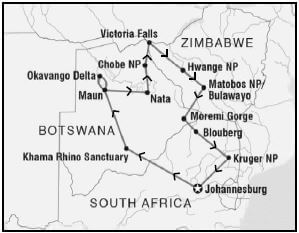
[Source; Adapted from Google Maps]
- route of the tour.
- capital cities to be visited.
- provinces to be visited.
- casinos and spas on the tour.
1.1.2 A budget tourist would prefer this type of accommodation:
- Luxury game lodge
- Backpacker hostel
- Exclusive spa and wellness resort
- Upmarket boutique hotel
1.1.3 Building a hotel in an area will result in employment of locals, opportunities for entrepreneurship and other essential services. This chain reaction is commonly referred to as the … effect.
- ripple
- multiplier
- balloon
- visual
1.1.4 Advice given to tourists before long-haul flights to minimise the impact of jet lag:
- Eat a heavy meal before the flight.
- Do intense exercises before boarding.
- Enjoy a cup of strong coffee the night before.
- Get a good night's sleep before departure.
1.1.5 Beijing (+8) is … Lima (-5).
- ahead of
- on the same line of longitude as
- behind
- 5 lines of longitude west of
1.1.6 A mountain peak in the Swiss Alps:
- Jungfrau-Aletsch
- Machu Picchu
- Auschwitz
- Alcazar of Segovia
1.1.7 The Dome of the Rock and the Wailing Wall attract many tourists to this country:
- India
- Ireland
- Indonesia
- Israel
1.1.8 When visiting Arizona in the USA, tourists may want to see the …
- Statue of Liberty.
- Niagara Falls.
- Grand Canyon.
- Corcovado.
1.1.9 The Sydney Opera House is an Australian icon because of its unique …
- roof structure.
- ceiling paintings.
- marble walls.
- blue tiled roof.
1.1.10 The continents represented by the icons in the pictures below: 
- Africa and Australia
- South America and North America
- Asia and Australia
- Europe and Asia
1.1.11 The public sector responsible for dealing with employee disputes (disagreements) in the hospitality and tourism industry:
- Department of Transport
- Department of Health
- Department of Home Affairs
- Department of Labour
1.1.12 The calendar below is used as the … of a business or organisation. 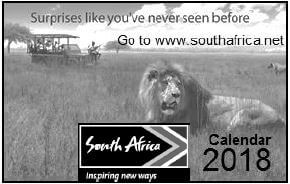
[Adapted from www.southafrica.net]
- legal documents
- marketing material
- customer services
- product packaging
1.1.13 As part of the code of conduct, the Hilton Hotel group does NOT allow its employees to accept gifts from guests or suppliers. This practice ensures that employees maintain …
- good communication skills.
- professional appearance.
- leadership qualities.
- professional accountability.
1.1.14 Tourists going to an area to see the damage caused by an unforeseen natural occurrence is an example of … tourism.
- sustainable
- responsible
- disaster
- leisure
1.1.15 The promotion of indigenous flora and fauna is an example of this type of responsible and sustainable tourism:
- Corporate social investment
- Environmental responsibility
- Economic responsibility
- Social responsibility
1.1.16 The public sector responsible for reviewing the White Paper on the Development and Promotion of Tourism in South Africa 1996:
- SATSA
- NDT
- TBCSA
- DTI
1.1.17 An annual event hosted in South Africa:
- Wimbledon
- Winter Olympics
- Tour de France
- Comrades Marathon
1.1.18 The photograph below shows … 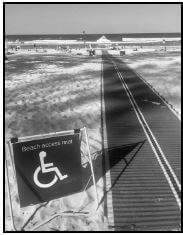
- continental access.
- the clean-our-beaches campaign.
- a warning against shark attacks.
- universal access.
1.1.19 A natural disaster where a huge wave of seawater destroys coastal tourist destinations:
- Windmill
- Snow storm
- Tsunami
- Waterslide
1.1.20 The owner of a guest house must consider the feedback on … complaints obtained from surveys when developing a plan of action.
- irrelevant
- common
- unfair
- insulting (20 x 1) (20)
1.2 Give ONE word/term for each of the following descriptions by choosing a word/term from the list below. Write only the word/term next to the question number (1.2.1–1.2.5) in the ANSWER BOOK.
| feedback; length of stay; credit card; expenditure; itinerary; electronic fund transfer (EFT); climate change; HIV/Aids |
1.2.1 A method of payment allowing a tourist to pay at the point of sale and settle the account at a later date
1.2.2 The convenience of using a computer or mobile device to make payments from home for concert tickets
1.2.3 A method used by tourism businesses to evaluate service delivery
1.2.4 The term that refers to the average spending by tourists per day
1.2.5 The focus of the COP 23 global summit held in 2017 (5 x 1) (5)
1.3 Choose the correct word(s) from those given in brackets. Write only the word(s) next to the question number (1.3.1–1.3.5) in the ANSWER BOOK, for example 1.3.6 passport.
1.3.1 Cabin crew members can obtain information on the airline's uniforms in the (code of conduct/contract of employment).
1.3.2 Payment for overtime work may be regarded as (a fringe benefit/ annual leave).
1.3.3 Personal (itineraries/insurance) is/are developed by travel agents.
1.3.4 A long-haul flight without crossing time zones will result in passengers experiencing (jet lag/jet fatigue).
1.3.5 It is the responsibility of (ACSA/SAVRALA) to inform passengers about the safety of their luggage at airport terminals. (5 x 1) (5)
1.4 Choose the type of occurrence from COLUMN B that matches the description in COLUMN A. Write only the letter (A–F) next to the question number (1.4.1–1.4.5) in the ANSWER BOOK, for example 1.4.6 G.
| COLUMN A | COLUMN B |
1.4.1 The WHO issues a worldwide health warning on an outbreak of the Zika virus |
|
(5 x 1) (5)
1.5 Study the picture below and answer the questions that follow.
 |
The element of the budget that will pay for:
1.5.1 Flights, car hire, train tickets and boat trips
1.5.2 Passports, visas and health certificates
1.5.3 Unexpected events, such as flight cancellations, baggage loss, illness and death
1.5.4 Visits to theme parks, night clubs, and casinos
1.5.5 Optional tours, shopping and gifts (5 x 1) (5)
TOTAL SECTION A: 40
SECTION B: MAP WORK AND TOUR PLANNING; FOREIGN EXCHANGE QUESTION 2
2.1 Read the information below and answer the questions that follow.
| Tony had just returned to South Africa after a holiday in India. At OR Tambo International Airport he entered the green channel at customs. |
2.1.1 Name the public sector responsible for ensuring that travellers comply with the relevant customs regulations at South Africa's international airports. (1)
2.1.2 Give TWO reasons why Tony entered the green channel and NOT the red channel at customs control. (4)
2.1.3 During Tony's trip to India the temperatures ranged between 35°C and 40°C.
Advise Tony on the following:
- TWO reasons why he should drink only bottled water (4)
- TWO reasons why it is important to use sunscreen (4)
2.2 Read the information below and answer the questions that follow.
DREAM HOLIDAYS Which destinations are at the top of your wish list? |
2.2.1 State TWO elements of an itinerary. (2)
2.2.2 Give TWO reasons why Dream Holidays believes a carefully planned itinerary is the key to a successful holiday. (4)
2.3 Study the World Time Zone Map below, read the information and then answer the questions that follow. 
2.3.1
Karlien travelled from Johannesburg to Rome.
|
- Give the time difference between Johannesburg and Rome. (2)
- Calculate the time and date she will arrive in Rome. Show ALL calculations. (5)
- It is 08:00 in Rome and Karlien wants to call her friend in New York. Calculate the time her friend will receive the phone call in New York. Show ALL calculations. (4)
2.3.2 London practises DST.
- Explain the term daylight saving time (DST). (2)
- Discuss TWO positive impacts of daylight saving time for London (4) [36]
QUESTION 3
Study the information and the forex table below and answer the questions that follow.
A South African university choir has been invited to perform at an international music festival held in London (UK). | |||
EXCHANGE RATES | |||
COUNTRY | CURRENCY CODE | BBR | BSR |
United Kingdom | GBP | 16,09 | 17,18 |
United States of America | USD | 14.31 | 14.45 |
3.1 Calculate the amount in pounds that each student received when they exchanged R610,00 at the foreign exchange bureau at the OR Tambo International Airport.
NOTE: Round off your answer to TWO decimal places. Show ALL the steps of your calculation. (4)
3.2 When they returned to South Africa, one of the choir members exchanged £26,35 at a foreign exchange bureau at the OR Tambo International Airport.
Calculate the amount in rand he received. NOTE: Round off your answer to TWO decimal places. Show ALL steps of your calculation. (4)
3.3 List SIX factors that may have an impact on exchange rate fluctuations in South Africa. (6) [14]
TOTAL SECTION B: 50
SECTION C: TOURISM ATTRACTIONS; CULTURE AND HERITAGE TOURISM; MARKETING
QUESTION 4
You came across an old photo album belonging to your grandmother.
Study the six photographs (A–F) of a world tour in her album below and answer the questions that follow. 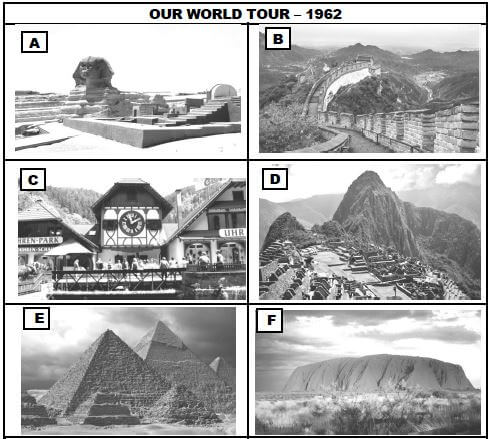
[Adapted from www.placestoseeinyourlifetime.com]
4.1 Identify the icons and the countries in the photographs (A–E) that your grandmother visited on her world tour.
Write down only the letter (A–E) and the name of the icon and country next to the question number (4.1.1–4.1.5) in the ANSWER BOOK, for example J Statue of Liberty – USA (10)
4.2
4.2.1 Give the number of countries your grandmother visited on her 1962 tour. (2)
4.2.2 Name the continent she did NOT visit. (2)
4.2.3 Identify ONE country she visited in the Southern Hemisphere. (2) [16]
QUESTION 5
5.1 Study the map below and answer the questions that follow. 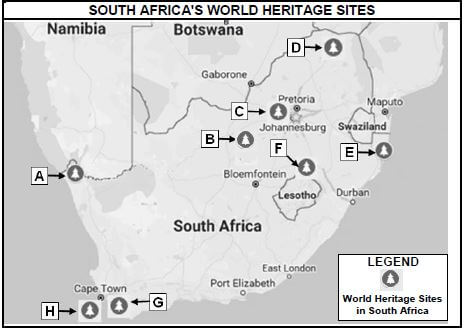
[Adapted from Google Maps]
Match the location of the World Heritage Sites (A–H) on the map with the names of the World Heritage Sites (5.1.1–5.1.5).
Write only the letters (A–H) next to the question number (5.1.1–5.1.5) in the ANSWER BOOK, for example 5.1.6 J.
5.1.1 iSimangaliso Wetland Park (2)
5.1.2 Vredefort Dome (2)
5.1.3 Cradle of Humankind (2)
5.1.4 Richtersveld Cultural and Botanical Landscape (2)
5.1.5 uKahlamba-Drakensberg Park (2)
5.2 Study the information below and answer the questions that follow.
THE ROLE OF UNESCO |  |
5.2.1 Name TWO provinces in South Africa that do NOT have World Heritage Sites. (2)
5.2.2 State TWO aspects UNESCO looks for when considering sites for World Heritage Site status. (4)
5.2.3
UNESCO'S CRITERION (iii) |
Name ONE South African World Heritage Site that matches the description in criterion (iii) above. (2)
5.2.4 Discuss TWO advantages for the South African tourism industry if South Africa is awarded another World Heritage Site. (4) [22]
QUESTION 6
Study the screen shot (picture) of a video on YouTube. 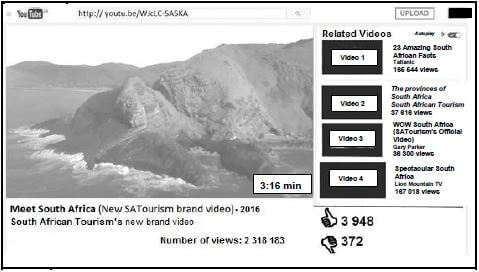
[Adapted from http://youtu.be/WJcLC-SA5KA]
6.1 Name the organisation that uploaded this video to YouTube. (2)
6.2 Apart from the new brand video in the screen shot above, give the name of TWO similar videos uploaded to YouTube. (4)
6.3 In a paragraph, evaluate the use of this video as a marketing strategy to showcase South Africa as a tourism destination. Your paragraph must include the following:
- Reasons for using YouTube to market South Africa
- Appropriateness of the title of the new brand video
- Viewership (6) [12]
TOTAL SECTION C: 50
SECTION D: TOURISM SECTORS; SUSTAINABLE AND RESPONSIBLE TOURISM
QUESTION 7
Study the information below and answer the questions that follow.
7.1
Good communication is a key consideration for businesses when it comes to maintaining a professional image. MANAGER'S RESPONSE TO THE COMPLAINT |
7.1.1 Name the document employees have to sign when accepting a position in the hospitality industry. (2)
7.1.2 Explain why the owner of this hotel can take disciplinary action against the manager after seeing the e-mail above. (2)
7.1.3 Explain ONE reason why the hotel's slogan 'We put you first' will be included in the hotel's customer feedback policy. (2)
7.1.4 The manager of the A1 Hotel has poor business writing skills.
- Identify TWO examples of poor written communication in the manager's e-mail that should NOT be used in business communication. (2)
- Correct TWO examples of poor written communication identified in QUESTION 7.1.4(a). (2)
7.2 Study the advertisement below and answer the questions that follow. 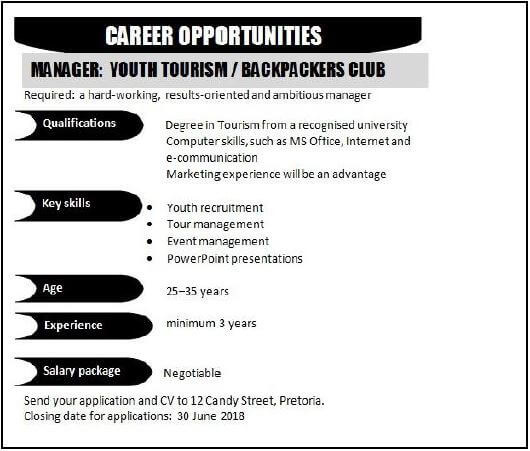
7.2.1 Refer to the advertisement above, name TWO values expected from the person applying for this position. (2)
7.2.2 Name TWO communication skills that are required for this position. (2) [14]
QUESTION 8
Study the information below and answer the questions that follow.
ARE YOU REALLY MAKING A DIFFERENCE? This article is based on a documentary on Blood Lions that was broadcasted on television. It investigates the lion hunting industry and provides some disturbing realities which have made Fair Trade Tourism review its position on wildlife sanctuaries (places of safety). The marketing manager of Fair Trade Tourism explains that the documentary reveals the following:
According to Fair Trade Tourism, since 1 June 2016, any organisation wanting to be certified by FTT may not allow any physical interaction between tourists and captive animals. [Adapted from Sawubona magazine, September 2016] |
8.1 Explain the contradiction (opposing views) highlighted in the documentary about lion sanctuaries. (2)
8.2 The principles of FTT:
- Ethical business practices
- Respect for human rights, culture and environment
- Fair wages and working conditions
- Fair distribution of benefits
- Fair operations, including procurement (buying from local suppliers)
- Sustainable practices
Read the principles of FTT above.
Identify the TWO principles of FTT NOT being practised by these lion sanctuaries. (2)
8.3 Discuss how EACH of the TWO principles identified in QUESTION 8.2 are in conflict with the practices exposed in the documentary. (4)
8.4 Discuss the main motivation for the abuse of these lions, according to the documentary. (2)
8.5 Suggest ONE way how FTT have tried to resolve (repair) this exploitation (abuse) in order to promote responsible and sustainable tourism. (2)
8.6 Explain TWO negative impacts this documentary can have on ecotourists wanting an authentic (real) South African wildlife experience in South Africa. (4) [16]
TOTAL SECTION D: 30
SECTION E: DOMESTIC, REGIONAL AND INTERNATIONAL TOURISM; COMMUNICATION AND CUSTOMER CARE
QUESTION 9
9.1 Study the information below and answer the questions that follow.
| IMPACTS OF FIFA WORLD CUPS |
 |
The funding for a FIFA World Cup is spent on the construction of new and existing infrastructure that will support the event. [Adapted from www.duke.edu] |
9.1.1 Refer to the extract, state ONE positive economic impact for countries hosting the FIFA World Cup. (2)
9.1.2 It is not guaranteed that hosting the FIFA World Cup will generate economic benefits. Discuss ONE reason why the host country would risk overspending knowing that there could be financial loss in hosting the FIFA World Cup. (2)
9.1.3 Recommend ONE way how the non-profitable stadiums in South Africa can be converted into income-generating venues. (2)
9.2 Read the information below and answer the questions that follow.
| HOTEL BURIED IN SNOW | |
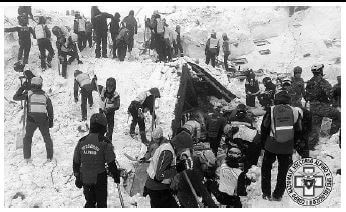 | After heavy snow storms and powerful earthquakes, an avalanche hit a hotel in Italy in 2017, killing 29 tourists and injuring 11 people. [Adapted from www.news.sky.com] |
9.2.1 Identify the type of unforeseen occurrence. (2)
9.2.2 Discuss TWO impacts the occurrence above may have on the ski resort in Italy. (4)
9.3 Study the information below and answer the questions that follow.
CASH SHORTAGE IN ZIMBABWE Tourists in Zimbabwe may not be able to withdraw cash from ATMs due to a cash shortage in the country. [Adapted from www.ftwonline.co.za] |
9.3.1 Explain ONE challenge tourists in Zimbabwe will experience when they want to withdraw cash at the ATM. (2)
9.3.2 Advise a tourist travelling to Zimbabwe on TWO ways to overcome the challenge in QUESTION 9.3.1. (4)
9.4 Study the information and answer the questions that follow.
| TOP 5 FOREIGN ARRIVALS BY AIR IN DECEMBER 2016 | ||
AIR MARKETS | ARRIVAL NUMBERS | 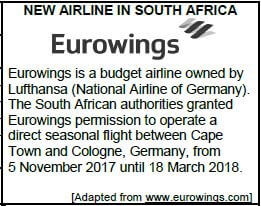 |
France | 13 952 | |
Germany | 31 603 | |
The Netherlands | 14 986 | |
United Kingdom | 53 462 | |
United States of America | 31 309 | |
| [Adapted from www.southafrica.net] | [Adapted from www.eurowings.com] | |
9.4.1 From the statistics, identify the air market from which South Africa receives its biggest foreign market share. (2)
9.4.2 With the introduction of the Eurowings flights, identify the existing air market that will show an increase in tourist arrivals to South Africa. (2)
9.4.3 Discuss ONE reason why the South African authorities granted Eurowings permission to operate in South Africa. (2) [24]
QUESTION 10
Study the extract below and answer the questions that follow.
 | A RESTAURANT GETS IT RIGHT Customers at the restaurant have complained about slow service and the quality of food. The restaurant therefore introduced an SMS feedback system. Customers are given a card with the restaurant's cell number requesting feedback via SMS. [Adapted from www.marketingminefield.co.uk] |
10.1 In the extract above, identify TWO advantages of using feedback via SMS. (4)
10.2 Give ONE other feedback method where customers can use technology for their complaints. (2) [6]
TOTAL SECTION E: 30
GRAND TOTAL: 200
TOURISM GRADE 12 MEMORANDUM - NSC PAST PAPERS AND MEMOS FEBRUARY/MARCH 2018
TOURISM
GRADE 12
NSC PAST PAPERS AND MEMOS
FEBRUARY/MARCH 2018
TOPICS IN THE TOURISM CAPS | ABBREVIATION | |
Topic 1 | Tourism sectors | TS |
Topic 2 | Map work and tour planning | MTP |
Topic 3 | Tourism attractions | TA |
Topic 4 | Sustainable and responsible tourism | SR |
Topic 5 | Domestic, regional and international tourism | DRI |
Topic 6 | Culture and heritage tourism | CH |
Topic 7 | Foreign exchange | FX |
Topic 8 | Communication and customer care | CC |
Topic 9 | Marketing | M |
MEMORANDUM
SECTION A: SHORT QUESTIONS
QUESTION 1
1.1
1.1.1 | A✔ / route of the tour | MTP |
1.1.2 | B✔ / Backpacker hostel | MTP |
1.1.3 | B✔ / multiplier | FX |
1.1.4 | D✔ / Get a good night’s sleep before departure | MTP |
1.1.5 | A✔ / ahead of | MTP |
1.1.6 | A✔ / Jungfrau-Aletsch | TA |
1.1.7 | D✔ / Israel | TA |
1.1.8 | C✔ / Grand Canyon | TA |
1.1.9 | A✔ / roof structure | TA |
1.1.10 | B✔ / South America and North America | TA |
1.1.11 | D✔ / Department of Labour | TS |
1.1.12 | B✔ / marketing material | TS |
1.1.13 | D✔ / professional accountability | TS |
1.1.14 | C✔ / disaster | TS |
1.1.15 | B✔ / Environmental responsibility | TS |
1.1.16 | B✔ / NDT | DRI |
1.1.17 | D✔ / Comrades Marathon | TA |
1.1.18 | D✔ / universal access | DRI |
1.1.19 | C✔ / Tsunami | DRI |
1.1.20 | B✔ / common | CC |
(20 x 1) [20]
1.2
1.2.1 | credit card ✔ | DRI |
1.2.2 | Electronic Fund Transfer/EFT ✔ | DRI |
1.2.3 | feedback ✔ | CC |
1.2.4 | expenditure ✔ | DRI |
1.2.5 | climate change ✔ | DRI |
(5)
1.3
1.3.1 | code of conduct ✔ | TS |
1.3.2 | a fringe benefit ✔ | TS |
1.3.3 | itineraries ✔ | MTP |
1.3.4 | jet fatigue ✔ | MTP |
1.3.5 | ACSA ✔ | MTP |
(5)
1.4
1.4.1 | F✔ / diseases | DRI |
1.4.2 | A✔ / unrest | DRI |
1.4.3 | D✔ / civil war | DRI |
1.4.4 | B✔ / global recession | DRI |
1.4.5 | C✔ / terrorism | DRI |
(5)
1.5
1.5.1 | transport ✔ | SR |
1.5.2 | travel documents ✔ | SR |
1.5.3 | travel insurance ✔ | SR |
1.5.4 | entertainment✔ | SR |
1.5.5 | additional expenses ✔ | SR |
(5)
TOTAL SECTION A: 40
SECTION B: MAP WORK AND TOUR PLANNING; FOREIGN EXCHANGE
QUESTION 2
2.1
2.1.1 South African Revenue Services (SARS)✔
- Department of Home Affairs MTP (1)
2.1.2 He had nothing to declare.✔✔
The goods in his possession fall within, the duty free allowance.✔✔
- He is not in possession of any prohibited goods.
- He is not in possession of any goods imported for trade purposes.
- Not in possession of gifts carried on behalf of others as such goods are subject to the payment of import duties and other taxes. MTP (4)
2.1.3
- To ensure that the drinking water is safe and he avoids the risk of becoming ill. ✔✔
To prevent dehydration✔✔ MTP (4) - To protect him against sunburn ✔✔
To prevent too much exposure to the sun to avoid health related issues✔✔ MTP (4)
2.2
2.2.1 Transport✔
Accommodation✔
- Attractions
- Activities
- Time
- Date
- Tours and excursions / optional tours
- Cities and countries to be visited
- Additional information MTP (2)
2.2.2 They believe a carefully planned itinerary would ensure that the needs and expectations of the client are met. ✔✔
It would ensure smooth running of the holiday to create a valuable and memorable experience. ✔✔
- It includes all the essentials that suit the tourist profile and in return ensure they get excellent value for money.
- It can assist the tourist in planning their expenditure in advance making it a cost effective and structured holiday. MTP (4)
| 2.3 | 2.3.1 | (a) | Johannesburg+2 | Rome +1 | MTP (2) |
Time difference | = 1 hour✔✔ |
| 2.3.2 | (b) | Johannesburg +2 Time difference | Rome +1 = 1 hour | MTP (5) |
Time in Rome Flying time | 14:00 (–)✔ 1 hour = 13:00✔ 13:00 (+)✔ 14 hours = 03:00✔ (7 February 2018) ✔ OR 03:00✔✔✔✔ (7 February 2018) ✔ |
| 2.3.1 | (c) | Rome +1 | New York -5 | MTP (4) |
Time difference Time in New York | = 6 hours✔✔ 08:00 (-)✔6 hours = 02:00✔ OR 02:00✔✔✔✔ |
2.3.2
- A practice of turning the clock one hour ahead of standard time at the beginning of summer to gain extra daylight hours.✔✔ MTP (2)
- More daylight time available to spend outdoors ✔✔
More time to participate in leisure activities, e.g. shopping ✔✔- Less crime.
- Save electricity
- Attractions opened for longer hours
- Economic benefits due to longer shopping hours MTP (4) [36]
QUESTION 3
3.1 R610 (÷)✔17,18✔= £✔35,51✔
- £35,51✔✔✔✔ FX (4)
3.2 GBP26,35 (x)✔16,09✔= R✔423,97✔
- R423,97✔✔✔✔ FX (4)
3.3
- Political unrest✔ / instability
- Natural disasters✔ / drought/water crisis
- Negative Credit Ratings✔ / junk status
- Corruption in government✔
- Discovery of new/large amounts of mineral resources✔
- Lack of investor confidence✔
- Hosting of successful global events
- Impact of major currencies (positive and negative)
- Interest rates
- Acts of terrorism FX (6)
- Reshuffling of cabinet ministers
- Economic recession
- High crime rates
- Positive / negative image of the country in media reporting
TOTAL SECTION B: 50
SECTION C: TOURISM ATTRACTIONS; CULTURE AND HERITAGE TOURISM; MARKETING
QUESTION 4
4.1
4.1.1 A – Sphinx✔ Egypt✔ TA (2)
4.1.2 B – Great Wall of China ✔ China✔ TA (2)
4.1.3 C – Black Forest ✔Germany ✔ TA (2)
4.1.4 D – Machu Picchu ✔Peru✔ TA (2)
4.1.5 E – Pyramids ✔ Egypt ✔ TA (2)
4.2
4.2.1 Five/5✔✔ TA (2) 4.2.2 North America✔✔ TA (2)
4.2.3 Australia/Peru✔✔ TA (2) [16]
QUESTION 5
5.1
5.1.1 E ✔✔ CH (2)
5.1.2 B ✔✔ CH (2)
5.1.3 C ✔✔ CH (2)
5.1.4 A ✔✔ CH (2)
5.1.5 F ✔✔ CH (2)
5.2
5.2.1 Eastern Cape ✔ and Mpumalanga✔ CH (2)
5.2.2
- Sites must be of outstanding universal value.✔✔
- Sites must meet at least one out of ten of UNESCO’s selection criteria.✔✔ CH (4)
5.2.3 Mapungubwe Cultural Landscape✔✔
- Ukahlamba Drakensberg Park
- Richtersveld Cultural and Botanical Landscape
- Khomani San Cultural Landscape
- Cradle of Humankind
- Robben Island
NOTE: Only accept the correct official name of the WHS CH (2)
5.2.4 Will attract more special interest tourists to South Africa.✔✔
More exposure/publicity for South Africa internationally.✔✔
Increased visitor numbers to the province/area where the new WHS is located.
- Local traditions and cultures at the new site will be showcased.
- More opportunities for entrepreneurship at the new site.
- Multiplier effect will come into motion.
- Increase in the GDP
- More sites of significance are protected for future generations.
- Job opportunities are created
- Positive impact on the geographical spread CH (4) [22]
QUESTION 6
6.1 SATourism/South African Tourism ✔✔
NOTE: Do not accept SAT
6.2 The provinces of South Africa ✔✔
WOW South Africa ✔✔
- 23 amazing South African facts
- Spectacular South Africa
6.3 Reasons for using YouTube for marketing
Real-life experience – a video clip does more justice to a destination than pictures in a book or brochure. ✔✔
- Many people across the world prefer to watch videos rather than paging through books or brochures.
- Takes potential tourists on a virtual tour of South Africa.
- Easily accessible on many different electronic devices.
- Easy to share with others.
- The video remains on YouTube.
- Can be downloaded and re-watched at a later stage.
- Length: is short enough to reach the attention of people who are very busy.
- YouTube is a very popular digital platform.
Appropriateness of the title of the new brand video
Very appropriate – the title creates at sense of personal involvement and warmth by inviting viewers to 'meet' South Africa. ✔✔
- The tile is short and easy to remember.
- The title is simple and will be understood by most viewers.
- The word 'meet' in the title creates a sense of curiosity.
Viewership
Very successful in reaching audience. Looking at the number of views – exceeding 2, 3 million views.✔✔
- Taking into account that not all viewers 'like' a video, this received 3 948 'likes' (large number of likes)
- Viewership is not static – grows on a daily basis.
- The ability of viewers to 'share' the video creates a bigger viewer base. [12]
TOTAL SECTION C: 50
SECTION D: TOURISM SECTORS; SUSTAINABLE AND RESPONSIBLE TOURISM
QUESTION 7
7.1
7.1.1 Contract of employment✔✔ TS (2)
7.1.2 The owner has every right to take disciplinary action against the manager as he is not fulfilling his core duty as a manager to deal with customer complaints.✔✔
- He brings the image of the business into disrepute.
- He should address the issues raised by the customer and not make excuses.
- He speaks ill of the business.
- He is not adhering to the customer service policy as depicted in the slogan, “We put you first.” TS (2)
7.1.3 To establish whether the hotel’s delivery of service puts the customer first as promised in the slogan. ✔✔ TS (2)
7.1.4
-
- Hi✔
- WHAT DO YOU EXPECT!!!

- Use of emoticons
- i am sorry
- Poor punctuation and informal written communication
- No subject for the e-mail
- 'i' in small letters
- Cheers TS (2)
- Good day✔
We try to meet the requirements of a three star hotel. ✔- Do not use emoticons
- I apologise
- I regret
- Correct the e-mail with formal punctuation and by using formal business language
- Subject should always contain the title of the message
- Yours truly/sincerely
- Kind regards TS (2)
7.2
7.2.1 Hard working✔
Results oriented✔
- Ambitious TS (2)
7.2.2 e-communication✔
interpersonal communication✔
- verbal communication
- computer skills
- written skills
- presentation skills TS (2) [14]
QUESTION 8
8.1 Sanctuaries have good intentions in wanting to help orphaned animals but in many cases cubs are separated deliberately from their mothers. ✔✔
- Animal sanctuaries should adhere to conservation practices, but are often exploiting animals.
- Animals should be protected and not be exploited for medicinal purposes.
- Animals should be rehabilitated into the wild and not sent to farms for canned hunting. S R(2)
8.2 Ethical business practice✔
Respect for human rights, culture and environment ✔
- Sustainable practises S R(2)
8.3 Ethical business practice :
It is unethical to attract tourists to a wildlife sanctuary under the pretence of helping the lions when the lions are actually being abused. ✔✔ S R(2)
Respect for human rights, culture and environment:
- There is no respect for the environment when lions are taken out of their natural habitat for tourism and profit purposes. ✔✔
- There is no respect for the environment when lions are abused and exploited as is indicated in the documentary.
- Sustainable practices:
- Interferes with the natural breeding process and may cause a drop in lion numbers.
- Unable to survive in the wild, removal of their natural instincts. S R(2)
8.4
- To attract tourists at the expense of the defenceless animals. ✔✔
- To make a profit at the expense of the defenceless animals. S R(2)
8.5 According to Fair Trade Tourism, since 1 June 2016, any organisation wanting to be certified by FTT may not allow any physical interaction between tourists and captive animals. ✔✔ S R(2)
8.6
- Eco tourists will not want to be a part of this type of abuse and exploitation and will therefore not visit the wild life reserves in South Africa. ✔✔
- They will question even the wildlife reserves that have responsible and sustainable tourism practises in place – creating a negative perception. ✔✔
- Reserves that are making valuable contributions to the environment by conducting research will also be negatively affected by these practices.
- Every tourism business becomes suspect in terms of unethical business practice. S R (4) [16]
TOTAL SECTION D: 30
SECTION E: DOMESTIC, REGIONAL AND INTERNATIONAL TOURISM; COMMUNICATION AND CUSTOMER CARE
QUESTION 9
9.1
9.1.1 Construction of new and existing infrastructure that will support the event.✔✔
- Income generation
- Investment
- Job creation
- FOREX income
- Multiplier effect DRI (2)
9.1.2 Host countries use the event to show their capacity to host and market an event of this magnitude. ✔✔
- The host country receives worldwide exposure/publicity before, during and after the event.
- Events of this magnitude create a sense of unity/belonging/pride amongst citizens of the host country.
- The event has the ability to change negative perceptions of the host country. DRI (2)
9.1.3 The stadiums must be utilised for events other than sporting events and future events ✔✔
- The facilities at the stadiums can be hired out for other events.
NOTE: Accept examples of other types of events/activities DRI (2)
9.2
9.2.1
- Natural disaster✔✔
- Avalanche
- Earthquake
- Snow storm DRI (2)
9.2.2 Pre-booked ski holidays will be cancelled ✔✔
The hotel will not do business until it has been rebuilt.✔✔
- Tourists will be reluctant to book ski holidays and rather experience other types of holidays.
- People will lose their jobs.
- No tourists will result in loss of revenue for the hotel. DRI (4)
9.3
9.3.1
- Tourists will not be able to use any cards for cash withdrawals. ✔✔
- Tourists will not be able to withdraw cash
- Tourists will be stranded in Zimbabwe without cash. DRI (2)
9.3.2
- The tourist should carry US dollars for emergencies when entering the country.✔✔
- Pay with credit cards where card facilities are available.✔✔
- Make pre-payments (vouchers) for activities and meals where possible before the trip to Zimbabwe.
- EFT payments where possible
- Tourists should carry sufficient cash with them and not rely on withdrawals from ATMs. DRI (4)
9.4
9.4.1 The UK/United Kingdom✔✔ DRI (2)
9.4.2 Germany DRI (2)
9.4.3
- More tourists from Germany and neighbouring European countries will visit South Africa.✔✔
- Higher income will be generated from tourists travelling during the peak season.
- Cheaper flights from the budget airline will increase the German market to South Africa.
- Competition among airlines will keep ticket prices down benefitting South Africa’s tourism industry and the tourists. DRI (2) [24]
QUESTION 10
10.1
- The restaurant can get immediate feedback after the dining experience.✔✔
- The restaurant gets the opportunity to respond immediately to complaints. ✔✔
- The restaurant can change the negative perceptions of customers by giving discounts. CC (4)
10.2 Comments on social media platforms like Twitter, Facebook, etc. ✔✔
- Reviews on Tourism websites like TripAdvisor.
- Web-based responses
- Online surveys CC (2) [6]
TOTAL SECTION E: 30
GRAND TOTAL: 200
VISUAL ARTS PAPER 1 GRADE 12 QUESTIONS - NSC PAST PAPERS AND MEMOS FEBRUARY/MARCH 2018
VISUAL ARTS
PAPER 1
GRADE 12
NSC PAST PAPERS AND MEMOS
FEBRUARY/MARCH 2018
INSTRUCTIONS AND INFORMATION
In this examination you must demonstrate the following skills:
- Using the correct art terminology
- Using and implementing visual analysis and critical thinking
- Writing and researching within a historical and cultural context
- Placing specific examples in a cultural, social, political and historical context
- Understanding distinctive creative styles
Read the following instructions before deciding which questions to answer.
- This question paper consists of EIGHT questions.
- Answer any FIVE questions for a total of 100 marks.
- Number the answers correctly according to the numbering system used in this question paper.
- Questions appear on the left-hand pages, with visual sources on the right-hand pages.
- Ensure that you refer to the visual sources reproduced in colour where required.
- Information discussed in one answer will NOT be credited if repeated in other answers. Cross-referencing of artworks is permissible.
- Name the artist(s) and title of each artwork you discuss in your answers. Underline the title of an artwork or the name of a building.
- Write in a clear, creative and structured manner, using full sentences and paragraphs according to the instructions of each question. The listing of facts/tables is NOT acceptable.
- Use the following guidelines for the length of your answers. Note the mark allocation.
- 6–8 marks: a minimum of ½–¾ page (paragraph)
- 10–14 marks: a minimum of 1–1½ page(s) (short essay)
- 20 marks: a minimum of 2 pages (essay)
- Write neatly and legibly.
QUESTIONS
ANSWER ANY FIVE QUESTIONS.
QUESTION 1: THE VOICE OF EMERGING ARTISTS
1.1 Refer to FIGURE 1a and FIGURE 1b. Compare the different approaches of the artists.
Use the following guidelines in your discussion:
- Subject matter
- Influences
- Line, shape and colour
- Placements of the figures and buildings/structures
- Style of painting
- Mood/Atmosphere (8)
1.2 Write an essay on ONE South African artist that depicts his/her surroundings and own experiences from everyday life.
Refer to the following:
- Subject matter
- Influences
- Art elements
- Composition
- Style
- Possible meanings/messages (12) [20]
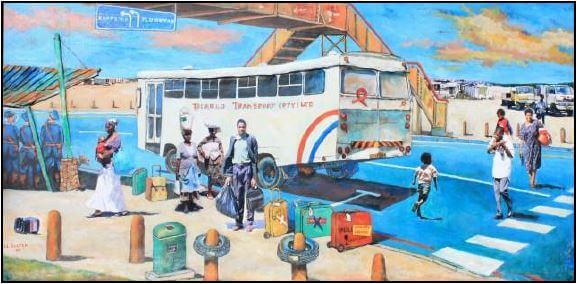
FIGURE 1a: Willie Bester, Township Life, mixed media, date unknown. 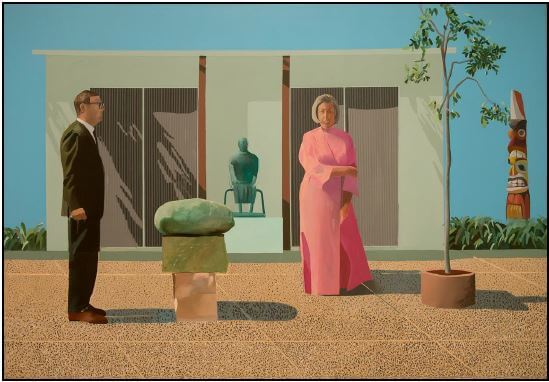
FIGURE 1b: David Hockney, American Collectors, acrylic, 1968.
QUESTION 2: SOUTH AFRICAN ARTISTS INFLUENCED BY AFRICAN AND/OR INDIGENOUS ART FORMS
Karel Appel said that his emotional expressions occupy a middle position between order and chaos. |
2.1 Discuss the statement above by referring to African and other influences in FIGURE 2a and FIGURE 2b.
You may include the following:
- Shapes and symbols
- Art elements
- Possible meanings/messages (8)
2.2 Discuss ONE artwork by ONE artist whose works are/were influenced by Africa.
Use the following guidelines in your answer:
- Subject matter
- Influences
- Symbols
- Style
- Possible meanings/messages (12) [20]
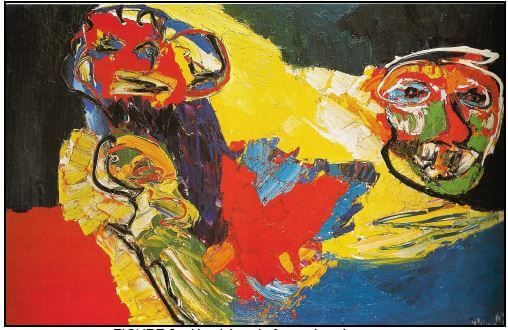
FIGURE 2a: Karel Appel, Angry Landscape, oil on canvas, 1967. 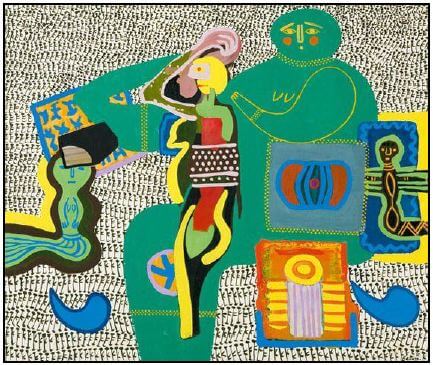
FIGURE 2b: Walter Battiss, Mother of the Tribe, oil on canvas, date unknown.
QUESTION 3: SOCIO-POLITICAL ART, INCLUDING RESISTANCE ART OF THE 1970s AND 1980s
As a voice against political and/or social injustices in society, artists use a combination of media and symbolism to convey a deeper message. |
3.1 Analyse FIGURE 3a and FIGURE 3b to comment on how these artists conveyed their voices of resistance.
You may use the following guidelines:
- Subject matter
- Media and technique
- Symbolism
- Possible meanings/messages (8)
3.2 Discuss the work of any TWO South African artists who use their art to convey messages of social and/or political issues.
Use the following in your answer:
- Subject matter
- Influences
- Art elements
- Media and technique
- Possible meanings/messages (12) [20]
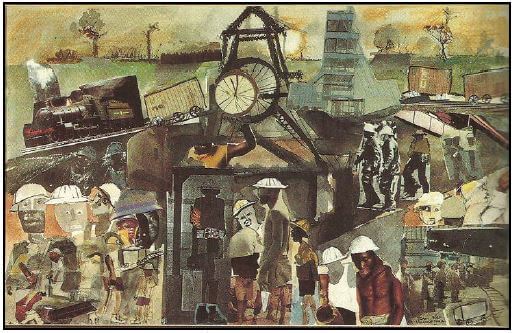
FIGURE 3a: Sam Nhlengwethwa, Shaft, collage and mixed media, 1987. 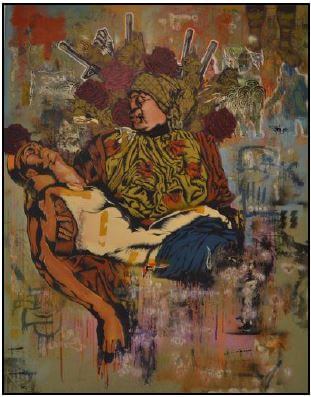
FIGURE 3b: Khaya Witbooi, Guns and Roses, oil and spray paint on canvas, 2012.
QUESTION 4: ART, CRAFT AND SPIRITUAL WORKS MAINLY FROM RURAL SOUTH AFRICA
The traditional African mask has always been used as a deeply spiritual expression for cultural and religious ceremonial reasons. Contemporary artists use the mask in many different ways. |
4.1 Discuss how the traditional mask has been reinterpreted by referring to FIGURE 4a to FIGURE 4d.
You may refer to the following:
- Use of recycled materials
- Techniques
- Possible meanings/messages (8)
4.2 Analyse the work of TWO South African artists who represent rural art, crafts and/or spirituality.
- Influences
- Art elements
- Media and techniques
- Possible meanings/messages (12) [20]
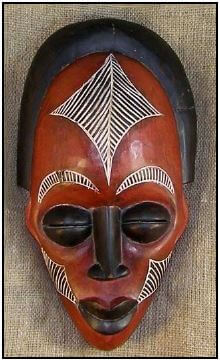
FIGURE 4a: Traditional African mask, wood and paint, date unknown. 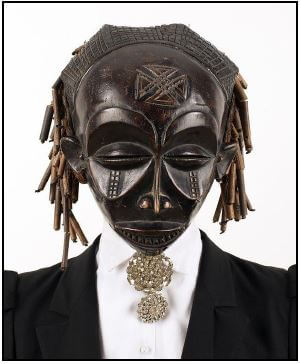
FIGURE 4b: Edson Chagas, Tipo Passe (Passport), date unknown. 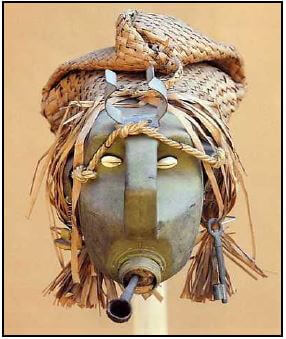
FIGURE 4c: Romuald Hazoumé, Dogon, recycled materials, 1996. 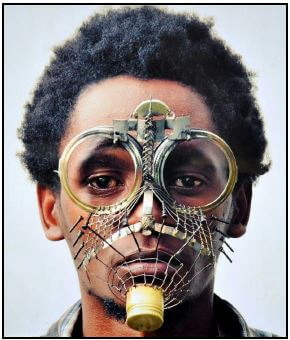
FIGURE 4d: Cyrus Kabiru, C-Stunners series, repurposed and recycled materials, 2012.
QUESTION 5: MULTIMEDIA AND NEW MEDIA – ALTERNATIVE CONTEMPORARY AND POPULAR ART FORMS IN SOUTH AFRICA
In the Bible, the Tower of Babel was a tower built up to the heavens by rich, corrupt and materialistic people. God punished their pride by tearing down the tower and sentencing them all to speak in different languages. |
5.1 Discuss Minujín 's artwork in FIGURE 5a.
Use the following guidelines:
- The significance of using books from around the world
- The size of the work
- Display of the artwork in a public space
- Use of site
- Interaction of the viewer
- Possible meanings/messages (8) .
5.2 Artists often portray their own interpretation of stories and myths and use different material and techniques to tell a story.
Discuss ONE artwork from TWO different artists who use unconventional/ interesting media and techniques to tell a story.
Use the following guidelines:
- Line, shape and colour
- Media and techniques
- Possible meanings/messages (12) [20]
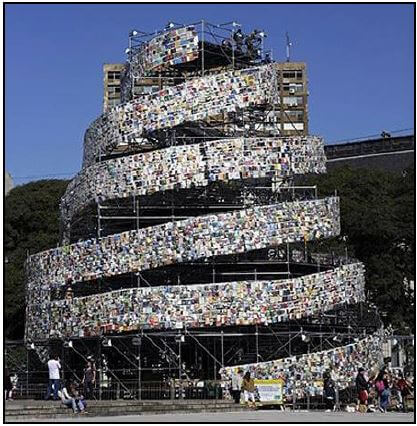
FIGURE 5a: Marta Minujín, Tower of Babel, books, scaffolding, 2011.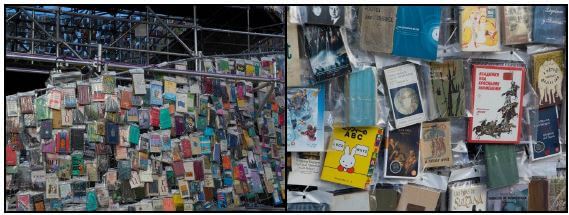
FIGURE 5b: Details of books and construction, 2011.
QUESTION 6: POST-1994 DEMOCRATIC IDENTITY IN SOUTH AFRICA
Zyma Amien's artwork pays homage to her mother and grandmother who worked in the textile industry. The textile industry has the reputation that they exploit women by paying them a minimum wage for long hours' work. |
6.1 Discuss how Zyma Amien portrayed this exploitation in her work by referring to the following:
- Description of the work
- Colour
- Symbolism (6)
6.2 Like Zyma Amien, many post-1994 democratic artists' work has developed from their own personal histories.
Discuss the work of any TWO relevant South African post-1994 democratic artists who explore their own identities.
You may refer to the following guidelines:
- Subject matter
- Influences
- Art elements
- Composition
- Style
- Possible meanings/messages (14) [20]
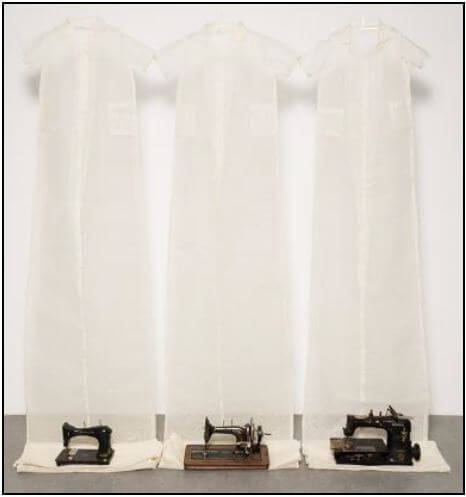
FIGURE 6a: Zyma Amien, Paying Homage, overalls made from gauze and sewing machines from different time periods, installation, 2016. 
FIGURE 6b: Zyma Amien, Paying Homage, close-up photograph, 2016.
QUESTION 7: GENDER ISSUES: MASCULINITY AND FEMININITY
| Contemporary society has a more tolerant approach to gender issues, which has allowed artists to break with stereotypes. |
7.1 Do you think the artists in FIGURE 7a and FIGURE 7b have broken with stereotypes?
Respond to the above statement by using the following guidelines:
- Visual appearance/body language
- Style and technique
- Mood and atmosphere
- Interpretation of gender issues (10)
7.2 Society has prejudiced ideas on masculinity and femininity.
Debate your viewpoint of this issue in a discussion of the work of TWO artists who commented on gender aspects in their work.
Use the following as a guideline:
- Subject matter/Themes
- Influences
- Media and techniques
- Style
- Possible meanings/messages (10) [20]
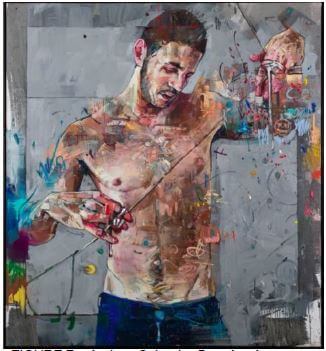
FIGURE 7a: Andrew Salgado, Drawing Lesson, oil- and spray paint on canvas, 2014. 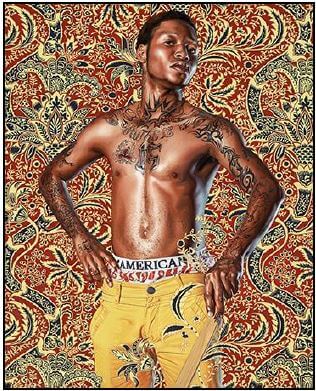
FIGURE 7b: Kehinde Wiley, The World Stage: Jamaica series, oil on canvas, 2013.
QUESTION 8: ARCHITECTURE IN SOUTH AFRICA
Francois van der Merwe Architects and PKA International Architects designed an intelligent green-star-rated government building in Tshwane that combines both the new and the old. A portion of the Agrivaal building was preserved and the new building 'clips' into the old building, therefore protecting South Africa's heritage. |
Analyse any TWO buildings you have studied this year by answering the following:
- Do you think it was a good idea of PKA International Architects to incorporate part of the old Tshwane building into the new design for the Agrivaal headquarters? Substantiate your answer by referring to your own examples.
- What structures have your chosen architects used in their buildings?
- Do you think that architects should maintain parts of old buildings when building/ designing a new structure? Substantiate your answer.
- Does your selected building reflect South Africa's heritage? Substantiate your answer.
- Materials
- Style
- Possible influences [20]
| Green-star rating: This rating system provides a series of green measures that can be used in the design/construction of a building to make it more sustainable, for example water, materials, land use and ecology, emissions and energy. |

FIGURE 8a: Francois van der Merwe Architects and PKA International Architects, Agrivaal headquarters for the Department of Public Works, corner of Hamilton and Edmond Street, Tshwane, tiles, glass, face brick, 2013. 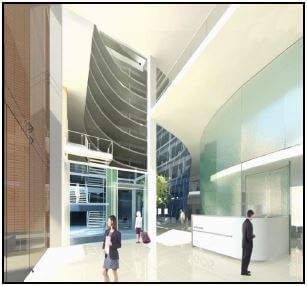
FIGURE 8b: Francois van der Merwe Architects and PKA International Architects, Agrivaal headquarters, tiles, glass, face brick, 2013 (interior).
TOTAL: 100
